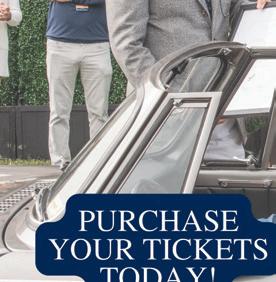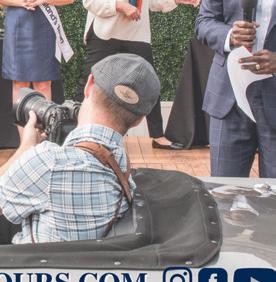






















































































































































































































































































































































































































































































































































































































































































































































































































































































































































































































































































WELCOME TO THE NEW EDITION OF GOODWOOD MAGAZINE. ese are the busiest months of our year, when we welcome hundreds of thousands of guests to the Estate to enjoy the extraordinary thrill of live motorsport – not to mention the delights of the English summer.
Our cover image of a vintage toy robot provides a clue to much of what we take pleasure in at Goodwood: the inventiveness, style and design inspirations of the past, alongside the game-changing innovations that lie ahead. FOS Future Lab has become one of the most exciting elements of the Festival of Speed, showcasing remarkable future technologies and inventions. is year, we look at what robots are going to deliver for humankind, while also investigating the latest breakthroughs in jet propulsion and data visualisation, into which we take a deep dive on p74. In this issue we also report on the rise of driverless race cars (p26) and celebrate 100 years of the Bugatti Type 35 (p23).
New technologies can sometimes a ord us a fresh perspective on the past. On p44, Marek Kohn explains how lidar, a revolutionary type of laser imaging, does just that, revealing the mysteries of ancient landscapes such as the South Downs, the chalk hills we are so lucky to call home. Delving into our own past, Goodwood’s curator Clementine de la Poer Beresford remembers some of the impressive women connected to the Estate and the integral role they played in its story (p58).
Elsewhere in these pages we discover what 2019 Magnolia Cup winner Khadijah Mellah did next; Dr Chris van Tulleken, who spoke at our Health Summit last year, explains why we urgently need to rethink our relationship with ultra-processed foods; Hannah Betts writes in praise of sporty fashion for non-sporty people; and Simon Mills o ers men a 10-point plan for stylish summertime dressing. We also extol the virtues of hedgerows – something very dear to our hearts here at Goodwood. And lastly, we profile Sir Kenneth Grange, the legendary designer who has overseen the creation of so many modern classics, from the InterCity 125 to the Kodak Instamatic camera.
We look forward to seeing you at Goodwood soon.


Robin Maynard
A distinguished environmental campaigner and nature writer, Robin’s career has included stints at BBC Radio 4’s Farming Today and Friends of the Earth, championing sustainable food and farming. On page 96 he examines the history and fightback of that threatened countryside feature, the humble hedgerow.

Kim Parker
Kim is a London-based fashion and beauty journalist whose work has appeared in Harper’s Bazaar, Town & Country, e Times, e Telegraph and Vanity Fair. Having competed in the 2022 Markel Magnolia Cup, on page 66 she looks back at the history of racing silks, tracing the colourful origins of this classic sporting attire.

Amelia Troubridge
London-based photographer
Amelia’s work has appeared in prestigious publications on both sides of the Atlantic including e New York Times, Vanity Fair, Tatler, GQ, Esquire, TIME and Rolling Stone. For this issue, she shot new portraits of 2019 Markel Magnolia Cup-winning jockey Khadijah Mellah, who is interviewed on page 52.

Nate Ryan
Nate has written about motorsport for three decades, covering NASCAR, IndyCar, IMSA and Supercross for USA TODAY Sports and NBC Sports Digital. Ahead of Richard “ e King” Petty’s eagerly awaited visit to the 2024 Festival of Speed, Nate reflects on the NASCAR legend’s enduring popularity on page 33.
Editor Sophy Grimshaw
Art director Vanessa Arnaud
Editorial directors James Collard Gill Morgan
Creative director Sara Redhead
Designer Camila Rivero-Lake
Sub-editor Damon Syson
Picture editor
Charlotte Maguire
Project director Sarah Glyde




Paul urlby



Lucy Johnston
Goodwood creative director Will Kinsman will.kinsman@goodwood.com
Goodwood brand projects Jennie Gott jennie.gott@goodwood.com
Goodwood
junior picture editor Max Carter
An award-winning, Brightonbased illustrator, Paul has created artwork for titles such as e New Yorker,Vanity Fair and e Times, as well as for clients including Vespa, John Lewis, Fortnum & Mason and e Bank of England. On page 84, for our Dressing Up column, he presents his take on fashion’s sport-inspired look.
Lucy is an author and podcaster who curates the Future Lab technology exhibit at Goodwood Festival of Speed. Her latest book, Kenneth Grange: Designing the Modern World, is the definitive appraisal of the revered designer and his work. Lucy is in conversation with Sir Kenneth for e Goodwood Interview on page 36.

Goodwood Magazine is published on behalf of The Goodwood Estate Company Ltd, Chichester, West Sussex PO18 0PX, by Uncommonly Ltd, 30-32 Tabard Street, London, SE1 4JU. For enquiries regarding Uncommonly, contact Sarah Glyde: sarah@uncommonly.co.uk
© Copyright 2024 Uncommonly Ltd. All rights reserved. No part of this publication may be reproduced without prior permission from the publisher. While every effort has been made to ensure the
of the
contained in this publication, the publisher cannot accept responsibility for any errors it may contain.

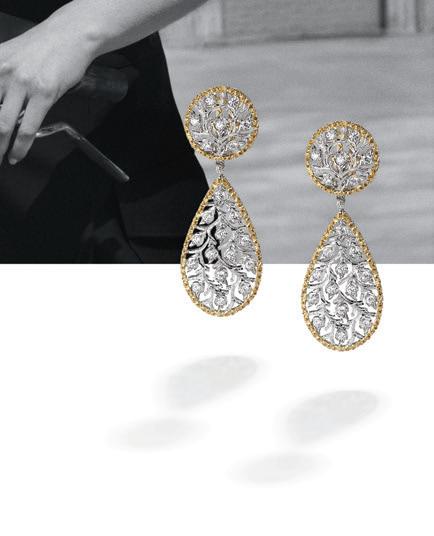
David
Can honey bees be saved?
Good day sunshine
Chanel Irvine’s English summer e winning type
Purple patch
Lavender
So power
Lucian Freud’s etchings
Calling



No matter how much the car changes, one thing stays the same: the feeling of Mercedes-Benz. DEFINING CLASS since 1886.
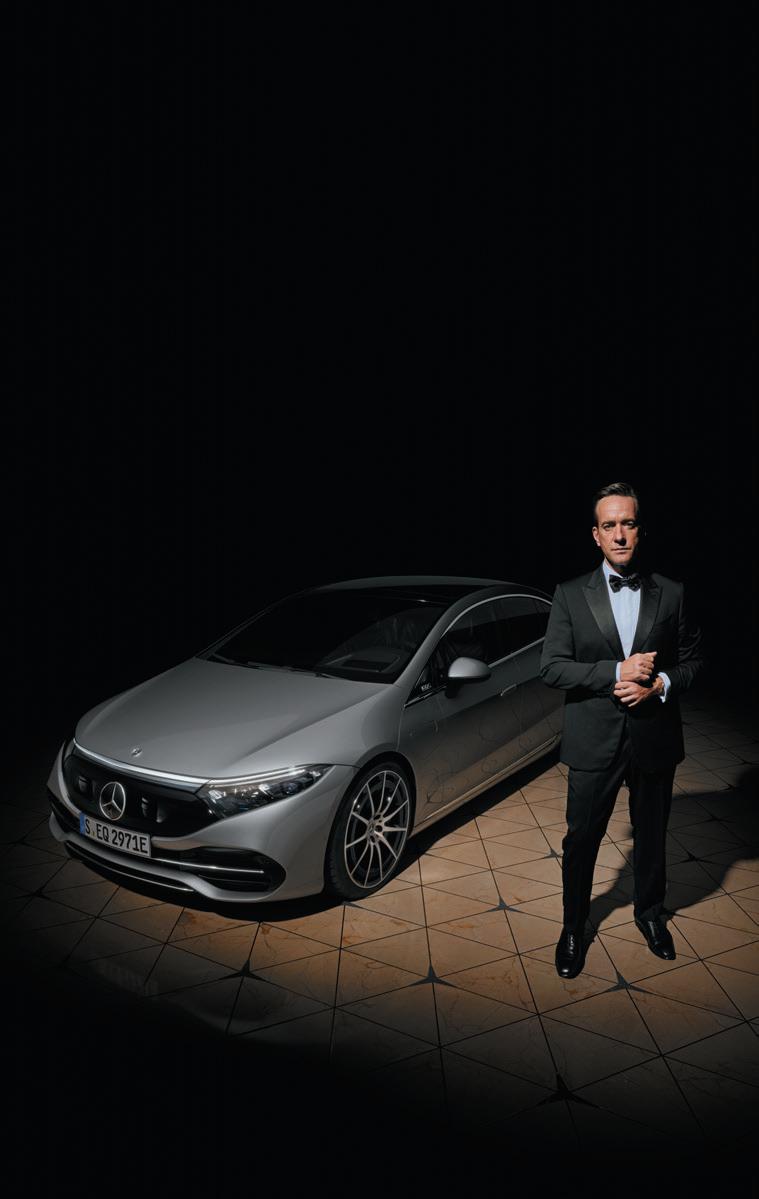
DEFINING CLASS since 1886.

IS THERE EVER ANYTHING SO COMPLETELY, often also so charmingly, dated as an old-fashioned vision of the future? Witness this Machine Robot, a battery-operated toy produced by the famous Japanese maker SH Horikawa in the 1960s. Although clearly made for children – it walks with a lovely swinging arm action, antennae moving and lights flashing – today it’s a collectible, and in some ways it feels current all over again. While the word robot – from the Czech robata, meaning forced labour – is about a century old, the ancients had similar notions, from legends of statues coming to life to the first automata developed in Ptolemaic Egypt, powered by hydraulics or steam. In the 20th century, electricity spurred the robot on – both as science-fiction-inspired toys like our cover star and as an industrial reality. Now robots are set to become daily presences in our lives, a hitherto fantastic notion explored at this year’s FOS Future Lab. Our favourite might just be the DAL-e – which uses autonomous driving and AI facial recognition to deliver a beverage (and other things besides) to your desk. Not so much a scary sci-fi thing of dread, then – think the T-1000 from Terminator II – as an automated “tea lady” for our times.




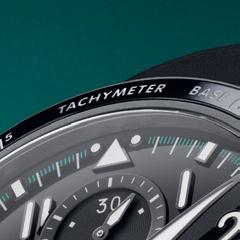





Pilot’s Watch Performance Chronograph Mercedes-AMG PETRONAS Formula OneTM Team



The new Pilot’s Watch Performance Chronograph 41 is the most performanceoriented IWC chronograph ever engineered. This version with a Ceratanium® case, an elaborate black lacquered dial, and appliqués filled with Super-LumiNova® is dedicated to our longstanding partner, the Mercedes-AMG PETRONAS Formula OneTM Team. IWC. ENGINEERING BEYOND TIME.

Noted: people, objects, news and ideas, from driverless race cars to the wonders of lavender and 100 years of the Bugatti Type 35
WORDS BY SOPHY GRIMSHAW
The Magnum co-founder’s work combined hard-hitting reportage with movie star portraits, like this


Sophia Loren, the still-living legend of the silver screen, says that she never actually spoke the words that LIFE magazine attributed to her in 1961: “Everything you see, I owe to spaghetti.” But at this point, perhaps that doesn’t matter. The phrase hung around for decades, seeming to chime with her persona of a liberated, curvaceous Italian enjoying the good life. One of Paramount Pictures’ leading lights of the 1960s, Loren won two Best Actress Oscars in that decade, and has a clutch of international awards to her name including five Golden Globes. Before all that, the young Sofia Costanza Brigida Villani Scicolone was living in a small apartment in Rome, the city where she had been raised in a decidedly modest home by an aspiring actress mother (she met her father only a handful of times).
“I photographed Sophia in 1955,” recalled Magnum photographer David Seymour of the shoot on the contact sheet pictured here. Loren would have been 20 or 21 in these images, and was still “a budding actress” rather than the full-blown movie star who would, in 1994, be awarded the 2,000th star on the Hollywood Walk of Fame. “We talked over the phone and I explained what I wanted,” said Seymour of setting up the shoot. “She invited me over
for a Sunday morning early meeting [and] I found her in bed in a dark blue negligee, although she was talking on the phone. She got up and changed costume, we went to a covered balcony of her apartment and I had nothing else to do but record a stream of poses which somehow met my memory of wartime pin-ups.” He added, intriguingly, “All this was done with a touch of irony and maliciousness.”
A Pole whose parents were killed by the Nazis, Seymour became a news and war reporter during the 1930s and much of his career was dedicated to capturing images documenting the effects of war on Europe. He also co-founded and was president of Magnum Photos. But these images of Loren speak to an additional, significant strand of his work in which he captured images of Hollywood stars in Europe. The year after he took these photos, he would be killed by machine-gun fire near the Suez Canal while trying to photograph a prisoner exchange. His sunny Sunday morning on a balcony in Rome with Sophia Loren lives on here. These images feature in the book Magnum Contact Sheets, published by Thames & Hudson; thamesandhudson.com


Rolls-Royce Spectre WLTP: Power consumption: 2.6 – 2.8 mi/kWh / 23.6 – 22.2 kWh/100km. Electric range 311 - 329 mi /500 - 530 km. CO2 emissions 0 g/km.
Official data on power consumption and electric range is determined in accordance with the mandatory measurement procedure and is compliant with Regulation (EU) 715/2007 valid at the time of type approval. The figures shown consider optional equipment and the different size of wheels and tyres available on the selected model. Changes of the configuration can lead to changes of the values. For vehicles that have been type-tested after January 1st, 2021, the official information no longer exists according to the NEDC, but only according to the WLTP. Values are based on the new WLTP measurement procedure. Only compare power consumption and electric range figures with other cars tested to the same technical procedures. These figures may not reflect real life driving results, which will depend upon a number of factors including the starting charge of the battery, accessories fitted (post-registration), variations in weather, driving styles and vehicle load. Further information about the official fuel consumption and the specific CO2 emissions of new passenger cars can be taken out of the “Guide to Fuel Consumption, CO2 Emissions and Electricity Consumption of New Passenger Cars”, which is available at all selling points and at https://www.gov.uk/co2-andvehicle-tax-












WORDS BY CHRISTIAN SMITH
From habitat loss to pesticides, British bees face a barrage of existential threats. But can these vital pollinators be brought back from the brink?
Our increased awareness of the threats to their existence has made the image of a bee something of a visual shorthand for the looming environmental crisis. As a wildlife icon, what the bee lacks in scale and majesty – compared with, say, the blue whale or the tiger – it more than makes up for with utility.
Almost 90 per cent of wild plants and 75 per cent of leading global crops depend on animal pollination. From apples to almonds, there are countless examples of foods that we and other animals consume that require pollinators. In short, human beings can’t survive without bees, though you wouldn’t always guess that from our actions.
The UK is home to 270 species of bee. They rely on wildflower meadows for food and shelter, but since 1945 the country has lost 97 per cent of these areas, and the pockets of bee-friendly habitats that remain are not always close to each other. This fragmentation is problematic because a foraging bee can’t fly for longer than about 40 minutes before it needs to feed on nectar. Many UK councils, parks authorities and private landowners have introduced schemes that allow areas of fields or parkland, or even roadside verges, to be left to grow. One example is South Downs National Park’s Bee Lines, which aims to provide better connection between
wildflower meadows. But whether or not these efforts will be enough to turn the tide of bee survival remains to be seen.
When it comes to pesticides, the issue is not just that these chemicals can unintentionally kill bees; some herbicides interfere with bees’ navigational abilities and breeding instincts. On Goodwood Home Farm, organic farming methods mean an absence of these chemicals. Moreover, bees are not merely visitors attracted to the Estate by its flora, they are also cultivated by beekeeper Jo Ambrose, who maintains six beehives in the orchard.
“I find it very rewarding to start off with a small nucleus of bees and watch it slowly expand to a full-size colony of 60,000,” says Ambrose. “You need to concentrate on what you’re doing and there’s no room in your head for anything else, so for me beekeeping feels like a form of meditation.”
As a member of the British Beekeepers Association, Ambrose is an “on-call” contact if a swarm of bees ever needs re-homing. “The honey bee has really suffered because of pesticides, parasites, disease, climate change and habitat loss,” she says. “It’s a bonus to be able to take honey from the hives but I only ever take the excess. The bees need their own honey in order to thrive.”
Chanel Irvine’s atmospheric photographs are a love letter to the simple pleasures of the English summer


WORDS BY SOPHY GRIMSHAW
“I’m South African, but I grew up in Australia from the time I was six, and we were lucky enough to have a beach house on the Sunshine Coast,” says photographer Chanel Irvine. “So before I moved to Europe,” – Irvine studied photography in Paris prior to moving to England in 2017 – “I had always experienced a very consistent, kind of guaranteed, hot summer.” She’s speaking today from her home in a Kent village, where she is taking a break from choosing flowers for her summer 2024 wedding. “I like how precious the season is in England, and how excited we are about summer in this country. It brings a sense of solace every year,” says Irvine, whose background is in documentary photography. “Perhaps it’s treasured because of how fleeting it sometimes is. As an outsider, I feel summer is celebrated more in this country than elsewhere. I like all the rituals,” she adds, and she doesn’t necessarily mean just the folkloric kind –maypoles and the Green Man – though she’s interested in those, too. “Even the simple things like everyone rushing to the park the minute the temperature hits 15°C, suddenly transported to a beach in their minds.”
Irvine’s appreciation for Britain during the warmer months is expressed in her prolific ongoing photography project, “A Study of Summer”. In 2022, some of her images were collected together as a book, An English Summer, but she continues to add to the project. Her muted, calm photographs depict not just beach scenes but also rural views from cosy caravans, families with their feet and fishing nets plunged into deep green rivers, and stunning British coastal landscapes, from craggy headlands to tidal pools – often under unapologetically overcast skies. “These photos are meant to feel quiet. There’s a funfair here and there, but I typically show peaceful moments, where people really are just absorbed in their surroundings.” One of these images presents her friend, the writer Rosalind Jana, making the most of a warm day in Shropshire by taking a dip in the river. “It was one of her favourite swimming spots in childhood, so she took me there,” remembers Irvine, who was in the area on an unrelated photo assignment for a magazine. “I feel like everyone kind of agrees that there’s just something magical about summer here, isn’t there?” chanelirvine.com











































































Ask a petrolhead to name the most successful racing car of all time. Formula 1 fans might nominate a Red Bull, Mercedes, Ferrari, McLaren or Lotus; sports car enthusiasts might propose an Audi, Porsche or Ford. All reasonable suggestions. Yet in terms of race wins, one car is so far ahead that it has almost vanished over the horizon of popular memory.
Launched 100 years ago, the Bugatti Type 35 was not only beautiful to look at, it also set new standards for technical brilliance. Ettore Bugatti understood that light weight was the key to drivability, reliability and performance, and his factory at Molsheim, near Strasbourg, was renowned for exquisite engineering.
The T35 was conceived as a racer from the start. The marque’s trademark egg-shaped radiator was truncated at the base, sitting lower and closer to the front axle for better weight distribution and aerodynamics. That axle was now a forged tube, lighter and stronger than traditional solid designs, and the car rode on elegant alloy wheels with integral brake drums, further reducing the unsprung weight.
Beneath the slim alloy bodywork lay another masterpiece, a 2.0-litre, eight-cylinder engine whose crankshaft was supported by no fewer than
five bearings for durability and power. Revving to 6,000rpm and breathing through twin carburettors, its 95PS (94bhp) could propel the 750kg machine to 120mph. Subsequent developments included a supercharged 2.3-litre version that accelerated from 0-60mph in just six seconds, with a top speed of 130mph.
The T35’s debut at the 1924 French GP was spoiled by faulty tyres, but thereafter it proved almost unbeatable in the hands of top drivers such as Albert Divo, Tazio Nuvolari, Louis Chiron, William Grover-Williams, Hellé Nice and Eliška Junková. It won the AIACR World Manufacturers’ Championship in 1926, the first Monaco Grand Prix in 1929 and five Targa Florio road races in a row. A commercial success, it was popular with amateur drivers, too; about 350 were built from 1924 to 1930, including road-legal versions. Most impressively, the T35 scored more than 1,000 race wins and at least as many podium finishes in a decade. Bear that in mind next time you hear last season’s Red Bull RB19 lauded as history’s greatest F1 car because it won 21 grands prix. Some cars are the stuff of legend with tales of glory that live on for a hundred years – and counting.
The Bugatti T35 will be celebrated at the 2024 Goodwood Festival of Speed

WORDS BY GILL MORGAN
Treasured since ancient times for its medicinal qualities, lavender is now having a horticultural moment as climate change hits British gardens
“Like lavender, I bloom in the most unlikely places.” So wrote Atticus, the Roman poet. And it’s true that England’s often chilly and soggy climes seem an unlikely place for this muchloved plant to flourish. Yet it does, to the extent that avenues of lavender in full flowering summer pomp are an archetypal feature of the traditional English cottage garden.
The plant’s origins lie much further south, in the Mediterranean, Persia and other parts of the Middle East. Its emotional, spiritual and medicinal properties have been treasured from antiquity – and indeed it is the Romans who are believed to have first brought lavender to the British Isles. Cleopatra is said to have used lavender oil in her romantic armoury when seducing Julius Caesar and Mark Antony, while traces were found in Tutankhamun’s tomb, no doubt helping to protect the young king in the afterworld. But despite these associations with warmer climates, this perennial woody shrub thrives in well-drained, chalky soil (of the sort in plentiful supply in the South Downs), with plenty of sun. The traditional English nursery rhyme and folk song Lavender’s Blue, first recorded in the 17th century as Diddle Diddle, Or The Kind Country Lovers, celebrates its role in romance – a-courting ladies would tuck a lavender pouch into their cleavage for added allure. Used to perfume all manner of soaps and waters, the origin of its name comes from the Latin lavare, to wash.
Long thought to help ward off evil spirits, it’s likely that such associations were firmly rooted in lavender’s inherent anti-bacterial properties: it was viewed as a protector along the lines of our Covid-19 vaccine in times of mediaeval plague and outbreaks of cholera. Loved by queens – Elizabeth I is thought to have had a vase of it on her desk each day – and paupers alike, there seems no end to its powers: antiseptic cure for wounds, moth deterrent, anti-anxiety medicine, sleep aid, muscle relaxant, even antidepressant. Today, biomedical and neuroscience research is providing contemporary evidence supporting what people have known for centuries. And now, in this challenging time of climate change, lavender is coming into its own with renewed vigour, as a plant that can withstand the extreme summer temperatures of recent years. Mixed with rosemary, euphorbia and grasses, it appears in abundance in the most modish of gardens, one of nature’s heroes – and survivors.


WORDS BY BEN OLIVER
This year’s Festival of Speed presented by Mastercard will see two driverless race cars going head-to-head on the Hill. Is this the shape of things to come for motorsport?
Motorsport is changing fast, reflecting the environmental concerns and technological advances of the world around it. From 2026, Formula 1’s hybrid cars will run solely on sustainable fuel. Goodwood Revival will get there two years earlier, with all competitors in this year’s event using fuels that add no new carbon to the atmosphere. The Formula E and Extreme E race series get rid of combustion engines altogether, and prove that you don’t need petrol and pistons to produce thrilling racing.
Getting rid of racing drivers, too, and replacing them with AI, would probably be a step too far for even the most forward-thinking fan, yet two of the most keenly anticipated cars to sprint up the Hill at this year’s Festival of Speed will be doing so without human assistance. We’ve seen it before, of course: the Roborace series ran for two seasons, sending its wildlooking cars to FOS, and the new Abu Dhabi Autonomous Racing League, A2RL, has just got under way with a day of racing at the Yas Marina Circuit.

But the Indy Autonomous Challenge is the only current race series for self-driving cars. Nine teams drawn from some of the world’s leading universities compete in almost identical machines supplied by legendary Italian race-car maker Dallara and powered by a pleasingly old-school turbocharged petrol engine. A profusion of cameras and sensors sprout from where the driver would usually peer out. The only difference between the cars is the software driving them, which each team must develop itself. The series has already raced at the hallowed Indianapolis and Monza circuits, among others, and one of its cars set a new autonomous land speed record at 192.2mph at the Kennedy Space Centre in 2022.
After making a static appearance at the Future Lab pavilion during last year’s Festival of Speed, two IAC teams will go head-to-head on Goodwood Hill this year after carefully mapping its infamous off-camber corners and forbidding flint wall. It will be the first time they’ve raced in the UK, and,
given the rate at which autonomous driving tech is advancing, they should decimate the times set by the Roborace cars.
Goodwood’s knowledgeable crowd will understand their mission. The aim isn’t to make racing drivers redundant, but rather to do what motorsport has always done: to test new tech in the toughest possible environment and, once proven, pass it down to cars we can all drive. The dream of completely autonomous cars that will convey us to any destination while we snooze is still some years off, but the same tech can already chauffeur us unaided in certain circumstances, and help human drivers to be safer all the time. The PhD students coding the cars you’ll see at Goodwood might one day go on to crack full self-driving. Until then, we can enjoy the spectacle of race cars that can not only power their way to the top of the Hill, but think their way up it, too.
Goodwood Festival of Speed runs from 11–14 July 2024


WORDS BY JAMES COLLARD
A dog in repose, shown just as it is about to receive a gentle pat, Pluto Aged Twelve seems an aesthetic world away from the work that made Lucian Freud so famous. But it’s one of the highlights of A Creative Collaboration, an exhibition of Freud’s etchings at London’s V&A, which explores the artist’s long collaboration with the late Marc Balakjian, a celebrated master printer.
Freud is renowned for his paintings – nudes, landscapes, portraits, including double portraits of people and dogs (with the dogs portrayed just as vividly as the people). But he was also an avid creator of prints, both at the start of his career in the 1940s and then again from 1982 onwards. In 1985, he began working with Balakjian – who, with his wife Dorothea, produced superb prints for artists including Freud, Leon Kossoff and Frank Auerbach from their print studio in a former Sainsbury’s in Kentish Town.
“They definitely seem more tender”, says Gill Saunders, the V&A show’s curator, of his etchings. “Perhaps because they tend to be close-up.” Freud often worked on vast plates, which, unusually, he balanced upright on an
easel, rather than working on the more typical draughtsman’s desk. On these, he created landscapes (After Constable’s Elm), portraits (of performer Leigh Bowery, and of Freud’s daughter in Bella in Her Pluto T-Shirt, which gives a cameo role to Pluto) and self-portraits. In the V&A show we see plates, but also cancelled works – scored and crossed out by the artist, yet still rather beautiful – and sets of proofs that show how artist and printmaker collaborated until they reached results both were happy with.
A treasure trove of trial proofs of etchings was acquired in lieu of taxes from Balakjian’s estate following his death in 2017. He was renowned for his rare ability to “get into the mind of an artist – a remarkable kind of intuition”, Saunders explains, while Freud found working in this art form both “satisfying and interesting. He was using a different graphic language.” The results of their collaboration endure.
Lucian Freud’s Etchings: A Creative Collaboration is at V&A South Kensington until 25 August 2024; vam.ac.uk
WORDS BY EMMA BALLARD
The first recorded female golfer is Mary, Queen of Scots, who was seen playing the sport in 1567 and is believed to have ordered the construction of the famous St Andrews Links during her reign. But more than 450 years later, she remains an outlier in what is still a male-dominated sport. In recent times, however – and especially over the past two decades –golf’s governing bodies and related industries have sought new ways to encourage more women to play, with varying degrees of success.
In the UK, female participation is around 25 per cent and women make up, on average, 13 per cent of a golf club’s membership, indicating that there is still plenty of work to do. One reason for a small increase in female players might actually have been the knock-on effect of golf having been the first sport that was opened up during the Covid-19 pandemic, with a small but noticeable 1.5 per cent increase in female membership at England Golf-a liated clubs in 2020.
Initiatives from England Golf such as Girls Golf Rocks (for girls aged 5-18) and its adult equivalent, Get into Golf –
which has a women-only option – have had a positive impact in breaking down traditional barriers and demystifying the sport. Part of the overarching strategy is to remove the need for a social circle to introduce you to the rules and norms of golf, and to build confidence, regarding both technique and etiquette, in newcomers to this centuries-old pursuit.
Golf at Goodwood offers a relaxed introduction to the sport, and the option of playing in a ladies-only group, with its four-week Get into Golf sessions. There are three categories – beginner, improver and “get out onto the course” – all of which are run by qualified PGA Professionals. “We also offer a Get into Golf membership that gives you the opportunity to have one-to-one golf lessons with a PGA Professional, as well as getting out onto the course during quieter times,” says Goodwood’s Sophie Ham. “And we run etiquette and rule sessions to help our golfers learn everything they need to know.” In this way, new female golfers are given the confidence and skills they need to get started. Mary, Queen of Scots would surely have approved.









































Ex-Rolf Meyer Collection 1924 MERCEDES 10/40/65 SPORT

High quality edition produced by John Bentley 1886 BENZ PATENT MOTORWAGEN THREE WHEELER REPLICA


of Benz, Mercedes, and Mercedes-Benz Motor Cars
Original Rudge wheel example 1955 MERCEDES-BENZ 300 SL GULLWING
Late series, disc brake example 1962 MERCEDES-BENZ 300 SL ROADSTER





Ex-Robert Arbuthnot, Edward Mayer, CWP Hampton 1928 MERCEDES-BENZ 26/120/180 S-TYPE SPORTS TOURER
Ex-Warner Brothers President John Calley 1955 MERCEDES-BENZ 300 SC CABRIOLET





























Channel Islands since new and just 13,215 miles recorded 1968 MERCEDES-BENZ 280 SL ROADSTER WITH HARD TOP
Rare right-hand drive example 1971 MERCEDES-BENZ 280 SE 3.5 CABRIOLET
1937 MORGAN 4/4 ROADSTER































Chichester, Sussex | 12 July 2024 | Entries Invited








Bonhams|Cars are delighted to announce this magnificent collection originally assembled by the late Tom Scott Senior to headline this year’s Goodwood Festival of Speed sale.


ENQUIRIES
+44 (0) 20 7468 5801 ukcars@bonhamscars.com bonhamscars.com/fos











WORDS BY NATE RYAN
After more than 60 years in motorsport, American driver
Richard “The King” Petty – who will be honoured at this year’s Festival of Speed – still delights in meeting his fans
Richard Petty’s success as a NASCAR driver is the stuff of motorsport legend. His 200 Cup Series victories and seven Daytona 500 wins are alltime records that look unlikely to be broken, while his seven Cup Series championships put him level at the top with Dale Earnhardt and Jimmie Johnson. It’s easy to see how he earned his nickname: “The King”.
Hailing from the tiny tobacco-farming community of Level Cross, North Carolina, Petty, who turns 87 this July, dominated NASCAR for much of a career that formally ended in 1992. He has remained a track fixture since, both as a team owner and a corporate spokesman for myriad sponsors, serving as an uno cial ambassador for the sport over eight decades.
As a second-generation racing superstar – his father, Lee, won the first Daytona 500 in 1959 and was also a three-time NASCAR champion – Petty is famed for always making time for his fans. Since his 1958 debut, he estimates he has signed more than two million autographs, commenting: “Very few people have signed more than I have. Some days you don’t sign any, and some days you do 3,000.” American motorsport icon Roger Penske remembers Petty sitting on the hood of his blue No 43 Plymouth Superbird for hours after races, meeting fans. These days, it’s often a selfie
that racegoers request – with his ever-present sunglasses, Stetson and ready smile, Petty is a highly recognisable figure – ideally one with his son Kyle, a stock car racer turned commentator.
Petty will no doubt have his pen at the ready during the 2024 Festival of Speed. He will be returning, accompanied by Kyle, for his first Goodwood appearance since 2019, as the Petty family celebrates its 75th year in racing (Petty Enterprises was founded by Richard’s late father, Lee). The current father-son duo will be showcasing the iconic No 43, and “The King” is set to be saluted on the balcony at Goodwood House.
“It’s such a prestigious event,” Petty says of his return to Festival of Speed, “and bringing the Superbird will make it even more special. Kyle will be driving, which adds another layer of significance.”
As always, much of the NASCAR star’s focus will be on meeting fans and interacting with the crowds. As he once said, “Those are the people who put me in business and they’re the reason I’m here. If it wasn’t for the fans, you probably would have to work for a living.”
Richard Petty and his son Kyle will be attending all four days of Goodwood Festival of Speed, from 11–14 July 2024

Tales worth telling, from the fascinating revelations of lidar imaging to the historic women of Goodwood.
Plus: e Goodwood Interview with Sir Kenneth Grange
Kenneth Grange
by Lucy Johnston
“The richness of the experience furnished me with a training which could not have been gained in any other way”

Known as Britain’s “moderniser in chief”, prolific multidisciplinary designer
Sir Kenneth Grange’s extraordinary career has seen him create an array of iconic products, from Kodak cameras and Anglepoise lamps to postboxes and parking meters. Now in his nineties, he sits down with his biographer, Lucy Johnston, curator of FOS Future Lab, for The Goodwood Interview
Sitting in his courtyard garden, basking in the welcome rays of May sunshine, and with his 95th birthday on the horizon, Sir Kenneth Grange cuts a dashing figure.
Sporting a jaunty Panama hat, long legs clad in tartan loungewear finished with a pair of Scandinavian felt clogs and big cra sman’s hands playing with the curved arm of his garden chair, he moves slowly these days – but the wit and the sharpness of thought are still very much present. He and his wife Apryl balance their time between this cottage in Hampstead – a cosy oasis of white walls and parquet floors, purchased in the 1970s – and a barn conversion in deepest Devon that embodies Grange’s collected influences from eight decades of work across international industry.
I have known Grange for most of my life through my grandfather, Dan Johnston, who in the early 1960s was Head of Industrial Design at the Council of Industrial Design (CoID), a then-flourishing postwar government body established to promote the value of good design in industry (later renamed the Design Council). Its Design Selection Service was set up by the CoID to match industry clients with a shortlist of highly rated design talent. An unknown but promising young designer called Kenneth Grange was placed on that list in 1956 and to this
day he credits it with bringing him his most important early breaks in design; notably the Venner parking meter and the Kenwood Chef food mixer.
It was a time of vision, determination and dynamism that began with the Festival of Britain, where a 21-yearold Grange cut his teeth; a golden era when design and manufacturing worked side by side to build a vibrant, world-leading modern industry across the UK. “It’s impossible to describe what it was like,” he says of those influential months of the Festival of Britain, “or for someone now to imagine themselves in the shoes of someone back then, who was witnessing that level of colour and vibrancy and innovation for the first time.”
Grange’s career is a journey that has run in parallel with the evolution of the wider design and manufacturing landscape in Britain and beyond. And, thanks to his habit of never throwing anything away, he has accumulated an exceptional archive – recently acquired by the V&A –including models, sketchbooks, technical drawings and thousands of photographs of his working processes.
Grange was born in Whitechapel, East London, in 1929 to Harry, a police constable, and Hilda, who worked long past retirement as a machine operator in a spring factory. His mother’s love of “gra ing to do good work” was a strong influence on Grange, as were his father’s skills as

HST diesel electric power car
The technical drawing on the left below depicts the final proposed profile for the cab of the High Speed Train (HST) diesel electric power car (later the InterCity 125). Having been commissioned to design the livery for a previous prototype, Grange took it upon himself to redesign the nose of the power car itself – below displaying the original launch livery he also specified. The first HST went into service in 1975 and the trains can still be seen today on some lines around the UK.




Kodak Instamatic 33 series
The sketch above, reproduced from Grange’s notebooks, records his early thoughts on the redesign of the structure and materials for the Instamatic camera, a US invention which he was commissioned to refine for a European sensibility. His eventual design for the 33 series (pictured left), which launched in 1968, became an overnight sensation across Europe, sold millions of units, and rocketed Grange to new levels of design industry fame.
Wilkinson Sword razor These concepts for a disposable razor (pictured below left) were made from painted wood and plastic in Grange’s Pentagram workshop in 1981. They show the proposed colour variations for the Wilkinson Sword Retractor – the first razor to feature a retractable blade, thus reducing manufacturing costs as no separate protective cap was required. The large volume of sales of this now ubiquitous model reinforced Grange’s standing as consultant design director for the business.
a practical cra sman. As a young teen during the World War II years, Grange spent long blackout evenings at the dining table, studying shrapnel his father had brought home from the Bomb Disposal Division, or working out the structural design of Spitfires from posters in order to build his own models in balsa wood. He was also fond of taking apart and reworking his beloved bicycle. All of this fuelled his endless fascination with how things are made.
In 1943, Grange surprised himself by putting up his hand in assembly when the headmaster asked if anyone would be interested in a bursary to attend art school. Four years studying commercial art at Willesden College of Technology followed. “Design wasn’t even a word that was in use back then,” he explains. “Certainly the practice of industrial design came out of the architecture studios in the years a er the war, and when I first started out, there were really very few of us in the profession.”
On leaving college, Grange found work experience at Arcon in Piccadilly, the star architecture o ce of the day, where he honed his skills in model-making. e o ce, which he has described as “a natural gatherer of the talent of the age”, was where he first experienced how the modern world could look, with white walls and sleek furniture and lighting. A er completing two years of National Service, working as an architectural draughtsman, Grange took up a role as a design assistant in the o ces of his mentor,
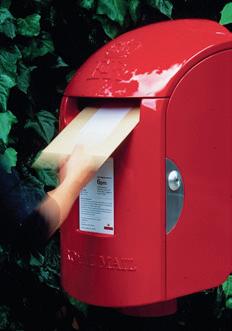
Royal Mail post box
Grange’s design for a new rural post box, created during his final year at Pentagram and launched soon after his retirement in 1998, took into account new trends: the wider slot allowed for the growing popularity of larger, hardbacked envelopes. The post box was nicknamed the Bantam by Royal Mail workers, because of its resemblance to the fuel tank of the classic red GPO Bantam motorcycle of the 1950s–70s.
Jack Howe. A key figure in mid-century design, Howe had previously been a partner at Arcon.
Learning much about both the practice and the business of design from Howe, Grange was encouraged to take on his own freelance design commissions. ese jobs were mainly exhibition stand designs – a vital part of industry in those postwar years. ey gradually grew in scale until, with Howe’s full support, Grange le to set up on his own. So it was that in 1956, marking the “single biggest turning point in his life”, the fledgling Kenneth Grange Design o ce was founded in the spare room of his flat in North London. From this moment on, his trajectory would be a constantly rising forward motion.
A er the early success of his distinctive Venner parking meter design, Grange’s “luckiest break” came while he was working on an exhibition design for the Kodak pavilion at the 1958 Brussels World’s Fair. A chance encounter led to a commission to redesign one of the US-made Kodak camera models for a more European sensibility. is would develop into a client relationship that lasted two decades and saw millions of Grange’s cameras sold – and the cultural icon status bestowed on the Instamatic would do much to establish his name as a dynamic figurehead for modern British design. Meanwhile, as he was cementing his early relationship with Kodak, another new client came calling: a gentleman

Kenwood Chef
In 1959, Ken Wood of the Kenwood Manufacturing Company commissioned Grange to give his original Americana-inspired Kenwood Chef “a new suit of clothes” to revive customer demand in Europe. On its launch in 1960 the new machine (pictured below) immediately became hugely popular, selling millions of units over the following decades, changing kitchens forever and proving Grange’s belief that over-engineered products stand the test of time.






Anglepoise Type 75 lamp
This sketch (right) explores the articulation of Grange’s first product design for Anglepoise, which refined the structural form of the original classic three-spring lamp conceived by George Carwardine in 1932 – described by Grange as “a minor miracle of balance”. His Type 75, launched in 2004, transformed the Anglepoise business, placing the timeless desk lamp back at the centre of a new consumer era attuned to the values of impeccable, functional, ageless design.
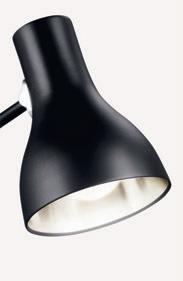



by the name of Ken Wood was in need of a revised design to improve the look of his food preparation machine, the Chef. Grange’s tenure as external design director for Kenwood would outdo even his era with Kodak, and saw him design over 120 kitchen appliances for the company, including four iterations of the enduring Chef itself.
“I was really thrown in at the deep end,” he recalls. “By the end of the 1950s I was employed by three very di erent types of company in Venner, Kodak and Kenwood. e richness of the experience furnished me with a training that could not have been gained in any other way”.
In all three of these early cases Grange was presented with a prototype or previous model of a product, with the brief to redesign and refine it for more modern tastes. e first thing he always did was take the object apart. “You learn by disassembly,” he says of this approach. “ at’s one of my great enthusiasms. You learn more by taking something apart than by trying to invent it from scratch.”
By now, design commissions were steadily rolling in and Kenneth Grange Design had become too big to run from his flat. So in 1961 Grange relocated to his first studio, at 7a Hampstead High Street, a much-loved address that o ered space not just for the team but also to install a proper workshop for making development models of his designs, the all-important trademark that remained at the heart of Grange’s working practice throughout his career. “It was the only medium in which I had confidence to sell my ideas,” he says of his models. e following decade also saw Grange indulge his love of cars. Never one to flash his growing wealth, his choices were “really always for fun, whether it was a Citroën Dyane or a Ferrari Dino”. In the early 1960s he bought one of the first Jaguar E-Types: “I caught a glimpse of it in an advert in the newspaper and it was the most extraordinary vision of the future I had ever seen. I simply had to have one.” By the end of that decade, Grange once again needed a larger studio. He joined forces with the celebrated architecture and graphic design o ce of eo Crosby, Alan Fletcher, Colin Forbes and Mervyn Kurlansky, with whom he had collaborated on designs for the UK’s first self-service petrol station forecourts for BP. e Pentagram design partnership was founded in June 1972, and rapidly became world-renowned. “At that point there were no other large, multidisciplinary design o ces in the UK”, recalls Grange, “and we really felt like we were stepping into a brave new world.”
e Pentagram years were wide-ranging in their scope and achievements, taking Grange all over the world and delivering titles, awards and recognition. Although his name is still not widely known outside the design industry, the mid-1970s would see one particular project bring him a global fanbase: the High Speed Train (HST), later renamed the InterCity 125. “ rough a brief to do the paintwork came the biggest job of my life,” says Grange. He took the initiative and spent the three weeks of his allotted time for designing a livery for the prototype power car working instead on redesigning its nose. Nights spent refining his design with models in the wind tunnel at Imperial College paid o when, although surprised by his uninvited design pitch, the British Rail design panel enthusiastically welcomed his input. ey proceeded to employ Grange to develop the final distinctive profile of the production power car, which would go on to set a diesel rail world speed record of 148.5mph that is still held today. e very first production power car – number 43002 – manufactured in 1975 and retired in 2019, now sits
in the centre of the National Railway Museum, restored to its original livery and renamed the Sir Kenneth Grange. Even today, a number of the power cars remain on rails around the globe, for commercial and pleasure use. Of his world-recognised design, Grange says, “When the HST first launched, it was the only modern thing in sight across the British landscape. ere was nothing else that approached it as evidence of the future and as a symbol of progress.” And of its longevity, he says, “My view has always been: ‘Make it as well as you can.’ Many of my products have been over-engineered; not just the train but also, for example, the Kenwood Chef. But that works to the good in my view, because once you embrace this ethos, inevitably the product is going to last much, much longer.”
He still speaks with great respect about the team of engineers who made the train possible, and of the thrill of visiting the Derby Works during those developmental years. roughout his career he has insisted on visiting the factories of his clients, to ensure that he fully understands their manufacturing processes and technical requirements. His favourite example of this approach is the range of speakers he designed for Bowers & Wilkins. First introduced to its founder, John Bowers, in 1973, Grange would work as the West Sussex firm’s external design director for four decades, devising such celebrated models as the 801, which set the bar for every loudspeaker that followed and became the reference monitor of choice for EMI at Abbey Road Studios. Grange was always mindful to collaborate closely with the company’s exceptional audio engineers so that he really understood how his three-dimensional forms could support them in delivering the “ultimate listening experience”. Looking back, he says, “It is fastidious attention to detail that marks out the superlative from the good. is requires e ort, which takes time.”
Retirement from Pentagram in 1998 did not bring retirement from the industry. Instead he returned to practising as an independent designer, keeping on a few favourite old clients, such as B&W, and taking on just a few new ones. e most notable of these has been Anglepoise, which quickly became very dear to Grange thanks to the company’s belief in making enduring products that can be handed down through the generations in lasting style. “ e demands of modern commerce have so dramatically changed our trade, and the system is now completely out of whack,” he stresses. “ ere must be a better way, where we focus on considering the materials and making, and appreciate the pure pleasure of good, simple design and long-lasting quality.” Appointed consultant design director for Anglepoise in 2003, he was instrumental in reviving the brand for the modern era, and continues to work closely on the next generation of designs.
Few individuals have contributed so directly to the evolution of British design and manufacture since those heady days of the Festival of Britain, yet Grange is characteristically humble about his achievements. “In Jack Howe’s and then my own generation,” he says, “it was far more possible for a designer to move between industry sectors, from architecture to trains. If a client trusted in their ability, that was what mattered.” And despite his modest habit of frequently mentioning “luck” as part of his story, it is Grange’s almost unrivalled ability as a designer that still shines through.
Kenneth Grange: Designing the Modern World by Lucy Johnston ( ames & Hudson) is out now
Modus March Lite chair
The stackable March chair was first developed by Grange for premium British furniture brand Modus in 2015 – in collaboration with Jack Smith of SmithMatthias, whom he had previously mentored at the Royal College of Art. Though well received, the first iteration was costly to produce in any volume, so Grange refined the design by “shaving it down”. The March Lite (right) was launched with great success in 2020.
Venner parking meter
The distinctive upside-down teardrop form of Grange’s design for the Venner parking meter (below) was first installed in Grosvenor Square, Westminster, in 1958. It became an iconic and ubiquitous feature of city streets in the UK for more than three decades, before being gradually replaced during the 1980s by electronic card-reading meters.







































and Britain’s leading luxury motor group










By
revealing
previously
invisible details of landscapes around us, the innovative technology of lidar scanning has proven to be a revelation for archaeologists, offering a fascinating glimpse of the past. Marek Kohn discovers its secrets
One day in March, 10 years ago, an aeroplane flew back and forth across a tract of Sussex land that includes the Goodwood Estate, scanning it with laser pulses. e data it gathered became the basis of a project that created a new map of the area’s past, and a new community devoted to seeing the landscape’s past in a fresh light. Titled “Secrets of the High Woods”, the collaboration between English Heritage and the National Trust was a model example of a new kind of archaeological investigation, in which volunteers and experts use the results of airborne laser scanning to reveal hitherto unknown marks le on the land by people hundreds or thousands of years ago. e technology is known as lidar, which stands for “light detection and ranging”, and indicates its kinship with radar, which is an acronym for “radio detection and ranging”. Over the South Downs, its story marks an upswing in a bittersweet historical arc. A hundred years ago, people began to take photographs from aircra , and aerial surveys in the middle decades of the 20th century revealed ancient traces that could not be seen at ground level. Lines in fields of crops, where the plants grew more or less strongly than their neighbours, betrayed the presence of underground structures such as walls or ditches. But even as the new evidence was being detected, it was being destroyed. Open downland went under the plough during World War II, providing crops to feed the nation, and the ploughing continued a er the war as more of the land was converted to arable fields. Heavy tractors and deep ploughing erased traces of human activity that had survived centuries or millennia of intensive but less invasive land use. While open landscapes dominate the eastern Downs, however, the west is more wooded. is pattern of land use dates back to the 12th century, when Norman lords began to create deer parks on their estates in the area. e woods remained standing, preserving the traces of the past within them. But those traces were not just undisturbed, they were largely invisible – until the advent of lidar, the technology that is said to “see through trees”. By revealing them, along with features in open land that had hitherto gone unnoticed because of their faintness, lidar is helping to turn sketches of past landscapes into richer pictures, adding subtle details that help to make sense of the whole scene. “Lidar o ers the
chance, both in the hidden landscapes of the woods and the obliterated landscapes of the east, to find ghosts of field systems and barrow groups and other structures,” says Matthew Pope, an archaeologist from Brighton who teaches at University College London, “and work towards a unified picture of prehistoric downland landscape use.”
Aerial lidar doesn’t really see through trees, but it does see through woods to the land beneath. It works by sending laser pulses downwards and recording them as they are reflected back from surfaces they meet. Some hit surfaces above ground level, such as leaves, while others pass through gaps in the vegetation and reach the ground. e data can be processed to create images that show either the land together with objects such as trees and buildings on it, or just the terrain with the objects removed.
ese images can then be manipulated to highlight anything that stands even a few centimetres above its surroundings – which may be all that’s le of an ancient feature. “When you’re walking through it, you don’t necessarily realise that there’s a ditch or a bank until you trip over it,” remarks Simon Crutchley, remote sensing development manager for Historic England. Time and ploughing, for example, may have spread the remains of a Roman road out to a width of up to 30 metres, with the centre le as little as 30 centimetres high. “You stand on it, and very o en you can’t see the damn thing,” says Mike Haken, who chairs the Roman Roads Research Association. “Lidar enables us to do that.”
Simon Crutchley regards the impact of lidar on archaeology as “transformational”, and Mike Haken’s group, which boasts more than 500 members, is a striking example of that impact. e RRRA was born in 2015, out of frustration with what Mike Haken and his collaborators saw as the inadequate state of Roman road mapping in England. “ e impetus for [forming the association] was the realisation that there was a group of individuals across the country who were starting to work with lidar,” Haken says. “If we want to understand the Roman period, we have to understand the whole network and infrastructure first. It’s been very much ignored until recently.” Lidar, it seemed, o ered the key.
e group’s mission is to build on the work of Ivan Margary, whose landmark book, Roman Roads in Britain, was first published in 1955. Margary systematised existing knowledge about Roman roads, numbering them

1. Trackways on the north face of the down between Westmeston Bostall and Plumpton Bostall
2. An overview of the South Downs mapping area reveals marks left on the land by people hundreds or thousands of years ago





according to a system like the one used for modern roads. His network included conjectures made on the basis of his reasoning about which places the Romans would have built roads to connect, and what routes those roads would follow. Number 153, he confidently asserted, ran eastward from Chichester to Brighton. Sixty years later, the High Woods lidar survey provided a faint but impressively straight line across the map that supported Margary’s claims about where the eastern end of the road had run.
Lidar-based work has added much more to the Roman road map than details like this, though. Studies led by a team from the University of Exeter have identified a whole network of Roman roads in Devon and Cornwall, a part of the country where evidence for such roads had previously been scarce. Even a er lidar scanning, evidence in much of the region was notable by its absence, so computer so ware did the kind of work Margary had carried out through poring over maps, analysing terrain to identi likely routes across the countryside.
By the time the findings were published last year, the whole of England had been surveyed by the Environment Agency’s National Lidar Programme. e freely available data is now the basis both for academic research, like the University of Exeter team’s work, and voluntary activities, like those of the Roman Roads Research Association. Full national coverage, Mike Haken says, is “what’s really changed the game. It’s completely redrawing the map. Across the country, I would estimate that we’ve increased the number of known Roman roads by about 50 per cent.”
Although lidar has transformed the study of past landscapes, it hasn’t replaced other techniques. Matthew Oakey, Historic England’s aerial survey principal, observes that a single project might draw on lidar data from a year before as well as photos taken from the air 100 years ago. Nor does lidar remove the need to check features detected in images by going out and looking for them on the ground, a procedure known as “ground-truthing”. e High Woods project was “exemplary”, Matthew Pope believes, in the way it combined its research techniques and its participants. Lidar generated the data; experts and members of the public used the images to identi features and then ground-truth them among the Sussex trees.
Truthing on the ground isn’t always possible, though, and lidar can enable people to do a lot of archaeological work that wouldn’t otherwise be feasible. It’s an inclusive application of technology, allowing people who can’t get into the field for a range of reasons – fitness, health, distance, the cost of archaeological digs, or just shortage of time – to survey landscapes from home. “It’s very democratising,” observes Matthew Oakey. “You don’t have to have privileged access to very specialist datasets and specialist so ware.” He notes that a number of projects recruiting “citizen” archaeologists arose during the Covid-19 lockdown, when ground-truthing was not an option. Having been forced to rethink its “Understanding Landscapes” community archaeology undertaking, the University of Exeter team came up with a lidar project they named “Unlocking Landscapes”. e free availability of lidar data may not be entirely a good thing. Pope cautions that putting out information about possible sites is like “putting out targets” for collectors and metal-detectorists pursuing their own interests, rather than those of the community as a whole. But lidar images can also enrich individuals’ relationships with their landscapes in ways that weave personal experience and community knowledge together. Archaeologists have been surveying and digging Britain for a very long time, so the chances of any spectacular new finds are limited – unlike in regions such as Amazonian Ecuador, where lidar has helped detect the remains of a dense network of towns more than 2,000 years old under the forest canopy. Instead, British lidar archaeology typically identifies features that are small enough for people to engage with on a level that feels more personal and relatable.
“ ese are landscapes that people will know intimately,” says Oakey. “ ey might have been going there for 40 years, walking their dog every day.” Lidar images show them the “big picture”. ey learn that the reason they go up and down a dip every time they walk into a familiar field is “because you’ve just walked across a 4,000-year-old field boundary. All of a sudden, that gives you a completely di erent connection to that landscape.”
Lidar o ers us a glimpse of the depths hidden below a few unassuming centimetres of earth, and our intimate bond with them.


Khadijah Mellah made headlines and history at Goodwood by winning the 2019 Magnolia Cup. Alex Moore meets her a er a morning on the gallops and discovers a jockey still breaking down barriers – and hears of her emerging passion for motorsport
Photography by Amelia Troubridge

Over Epsom Downs the sky is as blue as Godolphin silks and clear enough to see the arch of Wembley Stadium nearly 20 miles away. It’s been that way since 6am, at which point Khadijah Mellah would have been halfway round the gallops on Military Medal, the first of four racehorses she was exercising that morning. When we meet just a er noon, her working day is complete. Still dressed in jodhpurs, riding boots and a precautionary raincoat, she’s sore and exhausted but, by her own account, living the dream.
“When the sun’s rising and it’s nice weather, I feel like I should be paying for this experience,” says Mellah of her new position at Epsom’s legendary Loretta Lodge racing yard. We’re on the edge of Langley Vale, a mile from the yard, at a point where Mellah reckons certain horses have a habit of acting up. Sometimes they bolt when they realise they’re on the way home, she tells me. No such problems today though. ere’s a crack of thunder and suddenly it’s hailing. “On the other hand,” she jokes, pulling up her collar, “when the weather’s not so good, I feel I’m not getting paid nearly enough.”
It’s almost five years since Mellah won the Markel Magnolia Cup at the 2019 Qatar Goodwood Festival. e story of Britain’s first hijab-wearing jockey made headlines around the world, catapulting the 18-year-old A-level student from Peckham into the spotlight. Great British Racing logged over 1,400 TV and online pieces about her landmark victory, and it wasn’t long before leading talent agency Curtis Brown had signed her up. Such was the magnitude of the win and the circus that followed, even now she finds it overwhelming to look through her scrapbook of newspaper clippings.
“A er the Magnolia Cup, there was all this hype, all this energy, all this publicity,” says Mellah. “I was being invited to the same events as AP McCoy, a giant of the sport, and I’m just a pea. I was invited to ride at lots of di erent yards, but you have to remember, I hadn’t even been riding [racehorses] for three months. And I felt like people expected me to be much better than I was, so I had this huge imposter syndrome, and very little confidence in my ability.” She was invited into the Royal Box at Ascot with Queen Elizabeth II, but says her biggest “pinch me” moment was attending the same awards ceremony as two of her childhood heroes, English heptathlete Katarina Johnson- ompson and 400m sprinter Christine Ohuruogu: “Just to be in the same room as them was insane.”
Some timely words of encouragement from Hayley Turner, the first female jockey to ride 1,000 winners, eventually convinced Mellah she could belong at the sport’s top level, if she wanted to pursue it. “When it comes to interacting with people of colour, I think it’s easy to have subconscious bias, especially in the racing world, but Hayley never had any reservations about getting to know me, which was really refreshing,” recalls Mellah. “She’s been an incredible mentor in many ways, and I’ll always remember a piece of advice she gave me. She said, ‘Don’t compare yourself to other people, don’t worry about how everyone else is doing or what anyone else looks like; just do you.’”
With that in mind, Mellah decided to take a step back from racing and revert to her original plan of completing a degree in mechanical engineering at Brighton University. “Before I got involved in racing, I’d spent years working towards a very di erent goal,” she says prudently. “My dad has always fixed up cars and I really love motorbikes. And while I could see some sort of future in horseracing, I needed to get that [degree] behind me in case I got injured. Something to fall back on.”
During her studies, much of which she completed during lockdown, Mellah kept her toe in the racing world, helping champion jockey turned trainer Gary Moore exercise the horses at Cisswood Racing Stables near Horsham, West Sussex. Alongside ITV Racing’s Oli Bell, she also helped to found the Riding A Dream Academy, a charity that helps young people from diverse communities and disadvantaged backgrounds get into horse-riding. Inspired by Ebony Horse Club, the urban equestrian centre in Brixton where Mellah first learned to ride, the academy o ers taster days, residential weeks and the year-long Khadijah Mellah Scholarship. Already, she says, they’ve exceeded every expectation. “We’ve got loads of young people coming through the ranks who are almost riding at the same standard as I am,” she adds proudly. “So far, eight of our graduates have gone on to work in the racing industry. Every year we’re growing, and we’ve currently got students from Leicester, Solihull, Gloucestershire and London. We’ve got vulnerable kids from the foster system, some with
“We’ve got loads of young people coming through the ranks.
Last summer we ran a residential racing programme and 80 per cent of the students were Muslim”



“I fell in love with motorsport while I was at university. I’ve really got into Formula One”

learning di culties and others with disabilities. Last summer we ran a residential programme and 80 per cent of the students were Muslim.”
Indeed, Mellah has become something of a poster girl within the Muslim community. e academy works closely with the Muslim Sports Association (MSA) and she had a starring role in Nike’s tech pack commercial, sporting a Nike-branded hijab. “A lot of people in my community tend to stay away from the arts and sports and focus on academia because it’s the less risky path to success,” says Mellah, whose mother and father are first-generation immigrants from Kenya and Algeria, respectively. “Riding horses is actually encouraged within our religion; we just don’t typically have the access.”
Having finished her degree, Mellah decided to get back into racing fulltime. She wrote to a number of the country’s top trainers including Jim Boyle and Pat Phelan, both of whom o ered her work, but decided instead to join Adam West in Epsom – partly because of the proximity to London, partly because she knew West wouldn’t give her an easy ride.
“I didn’t want to just be this one-hit wonder,” says Mellah. “I don’t want to be celebrated to the extent I was celebrated last time – I just don’t like not being good at something. Yes, I won that race but I’m still nowhere near being a decent jockey. If I’m representing my community and my people, I want to be as good as I can be. I want to be taken seriously.”
Mellah is currently working towards her amateur racing licence in the hope of getting a few more races under her belt, not least Epsom’s Amateurs’ Derby in August. It’s been another steep learning curve. On her first day working under West, a dog ran onto the track, spooking the horse she was riding, Roly Poly. “He bucked me nice and hard,” she says from behind a trademark smile. “I think I had mild concussion. I’ve fallen o
horses, they’ve chucked me into bushes, thrown me into fences and I’ve even had a horse fall on me. It’s all part of the job.”
ese sporting mishaps are overshadowed, however, by the motorcycle accident she had in 2023 in which she broke her knee, ankle and toes. “Nothing comes close to that,” she says, clutching her knees, which are still swollen and ache badly a er riding. “But that time o only made me realise how fortunate I am to be in this position. It reinforced my love of racing.”
Could Mellah still see herself becoming a professional jockey? “I’m just not sure about the lifestyle,” she says, screwing up her face. “I’d have to be dieting, in the gym or in the bath sweating the whole time. And what with my other commitments, I don’t think I’d do the job justice.”
ere’s another reason, too. “I fell in love with motorsport while I was at university,” she says, sheepishly. “I’ve really got into Formula One. I’d love to do a crossover with [motorsport sensation] Jamie Chadwick – I’ve heard she also rides.” She pauses, clearly excited about the direction our conversation has taken. “Did you know Aintree used to host the British Grand Prix?”
e sun’s come out again and as we hobble towards the grandstand, the young jockey has an admission to make. “I went to Goodwood Revival last year and I can really see myself working in that [motorsport] industry in some capacity. I studied hydrogen combustion engines, so perhaps a job in the E Series, maybe in the media or presenting. As much as I love horseracing and always will, my big plan is to go into motorsport.” You certainly wouldn’t bet against her. And with that, she jumps on her moped and rides o into the Surrey sunset. She’s got a boxing class in an hour. is year’s Qatar Goodwood Festival runs from 30 July–3 August 2024. e Markel Magnolia Cup takes place on 1 August 2024

Goodwood House’s 2024 exhibition tells the stories of women connected with the Estate. Clementine de la Poer Beresford, the Collection’s curator, reveals the passions, power and pioneering spirit of these extraordinary individuals through the artefacts they le behind
For more than 300 years, women have been central to Goodwood’s history. Without the powerful and influential Louise de Keroualle in the 17th century, Goodwood as we know it, and the Dukes of Richmond, would never have existed. Without the determined spirit of Hilda, Duchess of Richmond in the 20th century, the Estate would likely have been sold o to pay crippling death duties. If women have been integral to Goodwood’s existence and continuity, they have also made its past infinitely richer. eir stories, which tell of passion, patronage, charitable work, family and, of course, sporting interests, have the power to interest, enthral and delight. We have much to thank them for. Goodwood’s history is o en told through the Dukes of Richmond, for they largely built Goodwood House and formed the art collection. Some women did contribute to the architectural and interior schemes, but their voices are quieter in the sources. Many more le less visible traces; they may not have le a legacy in brick and flint, paint or porcelain, but they are part of Goodwood’s history, and their stories deserve to be told. HerStory: Women of Goodwood is a celebration of the women associated with the Estate and the Gordon Lennox family, and it brings together portraits, dresses, accessories, letters and photographs to give us a window into their lives. Here, we delve into some of their stories through the objects that enable us to connect with them.
Louise de Keroualle, Duchess of Portsmouth
Louise de Keroualle, mistress of King Charles II and mother of the 1st Duke of Richmond, invites the viewer in this portrait to muse on her status, power and wealth. Her low-cut gown, almost exposing her breasts, the sensuous folds of material and the string of pearls disappearing underneath her bodice help signal to the viewer that she is the King’s mistress. Holding a shell, pearls and coral, Louise is Venus, the Roman goddess of love and desire, who was born of the ocean – a fitting depiction, as Louise was the King’s most loved mistress from 1671 until his death in 1685, and arrived at the Carolean court from her native France via the English Channel. In 1672 Louise bore the King a son and, with her position in his heart secure, she gained enormous power and influence, including titles for herself and her son. Wealth followed in the form of an annual income of over £1,000,000 in today’s money, allowing her to indulge her taste for expensive jewels – note the cluster of black table-cut diamonds that draw her dress together. In the 40 opulent rooms of her apartments at Whitehall Palace, she entertained the King and his ministers, and advanced French interests – the Francophobe English raged that she was “the spy in the bedchamber”. As a woman who wielded power in an age when women were typically barred from positions of influence, Louise was remarkable. She knew it, and proudly proclaimed it in this image.

Lady Emily Lennox
Growing up at Goodwood, Lady Emily Lennox, daughter of the 2nd Duke of Richmond, was high-spirited and an enthusiastic participant in amateur theatricals. Here, she wears a charming white and blue silk costume, donning a white hat with blue ribbon. Emily’s creative streak extended to fashioning the beautiful Shell House at Goodwood with her mother and sister, while her love of the outdoors and nature led to a particular fondness for the canaries and peacocks in her father’s menagerie. Marriage to the dashing Earl of Kildare and future Duke of Leinster meant a new life in Ireland, but she took elements of Goodwood with her, creating a shell house at her new home, Carton, and she wrote to her father to check on the wellbeing of her much-missed birds. Kildare adored his wife, and Emily was fond of him; the couple had 19 children, of whom 10 survived to maturity. Later in the marriage, though, Emily strayed, falling in love with her children’s tutor, and a er her husband’s death, she married him. One of the four famous Lennox sisters – all daughters of the 2nd Duke – Emily was not alone in attracting notoriety; her eldest sister, Caroline, eloped with a politician, and her youngest, Sarah, flirted with the future George III before marrying Charles Bunbury, eloping with William Gordon, and finally settling down with George Napier. It was only Louisa Lennox who led a scandal-free life, dedicating herself to charitable work and finishing her house in Ireland, Castletown.


Mary, Duchess of Richmond was a confident, free spirit, who passed through life “more happily than most”. She attracted criticism for flirting with men other than her husband, the 3rd Duke of Richmond, her lack of tact, her at times unusual choice of attire, and her ability never to tire of social occasions; but none of this seemed to faze her. To her sisters-in-law, the Lennox Sisters, she was distinctly odd and “not the kind of woman” they thought their brother would have chosen. She did not do things in the “Lennox way”. Jealousy and snobbery may have been at the heart of the criticism. Mary’s confidence shines through in this portrait. Wearing Turkish attire, she shows her awareness of the latest fashions – Turkish clothing was all the rage in England in the late 18th century. If her clothes were designed to shout that Mary was fashion-conscious, they also were chosen to reflect her “free” nature, as one contemporary put it. For western women in this period, Turkish costume came to symbolise the relative freedoms Turkish women, with their access to the all-female space of the harem, and their loose, uncorseted garments, were perceived to have. Mary’s creativity is also alluded to, as she holds and points to a decorative scrolling pattern, which we recently discovered relates to the decorative scheme in the Large Library of Goodwood House. While the 3rd Duke has o en been credited with designing the room, we can now write Mary back into the story.
Jane, Duchess of Gordon was renowned for her intelligence, humour and her role as a leading Tory hostess, but she was equally famous for her matchmaking. Ambitious for her poorly dowered daughters, she secured for them three dukes and a marquis, including Charles Lennox, future 4th Duke of Richmond, for her eldest, Charlotte. A er unsuccessfully pursuing Napoleon’s stepson for her youngest, Georgiana, her next target was the Duke of Bedford. When he unexpectedly died, she turned her attentions to his younger brother, and the couple were married within the year. For her matrimonial e orts, Jane was lampooned in popular satires. Here, stout and florid, she is shown running, pursuing the Bedfordshire bull, which gallops away, out of reach. She holds out a blue ribbon, tied together by a bow inscribed with the word “Matrimony”, to noose the bull. e satire makes it clear that the Duke of Bedford has little say in the matter of his forthcoming marriage. Jane’s matchmaking was to have a profound impact on Goodwood’s history. It was through the marriage of her eldest daughter, Charlotte, to Charles Lennox, future 4th Duke of Richmond, that the Estate would be saved financially in the 19th century.

Charlotte, Duchess of Richmond
Charlotte, Duchess of Richmond took delight in holding glittering soirées. When she and her husband, the 4th Duke of Richmond, moved to Brussels to avoid their creditors, she hosted the most famous dance in history, the Waterloo Ball. Charlotte used a hand-painted silk fan on the night, to cool herself, but also to gesture and communicate – as fans had their own language. She perhaps used it to thank her close friend the Duke of Wellington for allowing the function to go ahead – despite the news that Napoleon was advancing. When a messenger arrived mid-way through the evening to announce that Napoleon was much closer than anticipated, Charlotte perhaps employed her fan to exclaim dismay. O cers were ordered to depart and rejoin their regiments, and the bloody battles of Quatre Bras and Waterloo followed, with many fighting and dying in the uniforms they had worn at the ball. Wellington was forever grateful to Charlotte for keeping up morale in Brussels during the days before Waterloo, a erwards presenting her with Napoleon’s campaign chair (which remains at Goodwood). If the fan gives us a glimpse into Charlotte’s role as hostess at this most famous of gatherings, it also reveals her love of the exquisite and the expensive; she le behind a vast array of receipts relating to purchases for gowns of muslin and silk, shoes with silver trim, and enormous plumes of vulture feathers.

Amy, Countess of March’s life was tragically cut short at the age of just 31. But for a life so short-lived, she le behind a remarkable number of possessions that o er us a snapshot of her daily existence. As this illustrated image shows, she enjoyed making photograph albums and decorating them in the style of mediaeval illuminated manuscripts. is was a popular activity among Victorian women, as it improved their drawing and painting skills within the domestic sphere. Amy had a particular flair for it, and whiled away hours creating intricate patterns and collages. Amy’s interest in art extended to compiling catalogues for the pictures at Goodwood and Gordon Castle. ese were labours of love, which she dedicated to her “dear husband”, Charles, Earl of March (the future 7th Duke of Richmond). Amy organised the artworks in chronological order, beginning with the Stuarts and ending with the latest family members. Her detailed descriptions reveal a deep interest in the history of the sitters, as well as the aesthetic quality of the pictures. More than 100 years a er Amy put pen to paper, her grandson, the 9th Duke of Richmond, wrote, “ e family will forever be in debt to Amy for her wonderful achievement.” Today the picture catalogue at Goodwood is still arranged as Amy organised it.


Helen, Duchess of Northumberland was at the centre of fashionable society. e daughter of the 7th Duke of Richmond, Helen married Alan Percy, future 8th Duke of Northumberland, in 1911 – a marriage that was heralded as the “coming together of two of the greatest families in the land”. She hosted and attended spectacular parties, and this gown reveals her tastes for expensive designers, glamorous styles and the most up-to-date looks. Helen learnt and honed her skills as a hostess while growing up at Goodwood; from a young age she had hosted the glorious house parties during race week with her father, in the absence of her mother, who had died when she was just 11 months old. Helen entertained royalty, including Edward VII and Queen Alexandra. Photographs show her laughing with the King and sitting on his right-hand side (the most privileged position), and one even shows her with his famous terrier, Caesar, on her lap. As hostess, Helen sometimes clashed with her sister-in-law, Hilda, future Duchess of Richmond. Hilda was married to the Duke’s eldest son, and felt she should be hostess. When Helen married Percy, her hosting days at Goodwood ended, but she frequently visited, and perhaps in the 1930s wore something as glitzy as this when visiting for an evening soirée.
Susan, Duchess of Richmond, who sadly died in June 2023, was forward-thinking and ahead of her time. In this iconic portrait, taken by John Swannell for a Harper’s Bazaar photoshoot, she looks straight at the camera, wearing a bright blue 1980s shoulderless peplum dress. Together with her husband, the 10th Duke of Richmond, Susan oversaw the modernisation of Goodwood, laying the foundations for what the house and Estate have become today. A trailblazer of the organic movement, an early member of the Soil Association and supporter of animal welfare, she was instrumental in making Goodwood’s Home Farm pesticide-free; she took delight in seeing the resultant transformation of the countryside, the impact upon the birds, wildflowers and animals. A love of horses led Susan to start her own dressage competitions at Goodwood. ese took place outside the front of the house, well before her son Charles, the current Duke of Richmond and Gordon, founded the Festival of Speed. She introduced the novel idea of musical accompaniment to the sport and hosted 21 international dressage competitions. Susan’s values were also ahead of her time. In 1953, a chance encounter with Edith Buxton, daughter of the famous missionary C T Studd, kindled a deep interest in Susan and her husband in Africa, and they soon became deeply involved with Capricorn, a multi-racial pressure group. In the 1960s they adopted two mixed-race children from South Africa, welcoming Maria and Nimmy into the family. Susan was patron of many charities, including Compassion in World Farming, British Hen Welfare Trust and Stonepillow. To raise awareness for homelessness, she spent a night sleeping under the stars in Chichester.
HerStory: Women of Goodwood at Goodwood House can be seen on all Open Days between 5 May and 28 October 2024
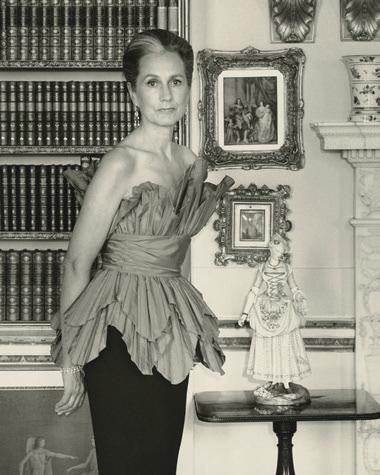



You’re in the driver‘s seat. We‘ll help keep you up to speed.







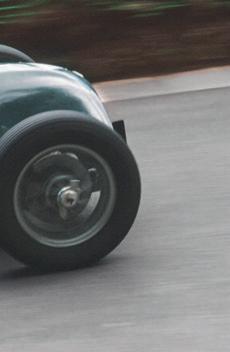




Flamboyantly coloured racing silks have a long and intriguing history, from helping aristocratic horse-owners identi their riders to capturing the imagination of many of today’s leading fashion designers, as Kim Parker discovers



Ican clearly recall the moment, two years ago, when I slipped on my racing silks for the very first time. Arriving at e Kennels at Goodwood to prepare for e Markel Magnolia Cup, my fellow jockeys and I were nearly dizzy with excitement, having trained for the best part of a year to take part in the prestigious annual charity race. All our pre-dawn rises, intensive practice rides, muscle-busting gym sessions and enthusiastic fundraising had led us to the moment when we would, at last, put on our “colours” and get ready for the ride of our lives.
Each year, Goodwood invites a British fashion designer to create a set of unique outfits for the Magnolia Cup’s line-up of female amateur jockeys (Vivienne Westwood, Bella Freud and Alice Temperley have all previously contributed designs) and ours had been created by Roksanda Ilinčić, who translated some of her archival motifs into 12 extraordinary pastel-tinted jackets with coordinating helmet covers. Buttoning my own dazzling, multicoloured jacket over my body protector felt transformative, akin to putting on Superman’s cape. “I remember thinking, ‘Wow, we are actually going to be jockeys now.’ As soon as I put [my silks] on, the dopamine hit hard,” agrees Ashleigh Wicheard, who went on to win the race. As she was the first Black woman to do so, her floral-print silks are now proudly on display at the National Horseracing Museum in Newmarket.
Beyond making us feel sensational, our colours also served a practical purpose, allowing Goodwood’s 30,000 racegoers (plus a global television audience) to distinguish between riders, even from a distance, as no two jockeys are allowed to wear the same design. Historically, racing colours genuinely were made of silk, which is lightweight and flexible, but not particularly hardwearing. It has since been replaced by machine-washable nylon or polyester, though the name “silks” has remained. In conventional racing, the outfits also represent a horse’s owner – a role they have played for more than three centuries.
“Most of the modern history of racing that we have today, including evidence of ‘colours’, comes a er the restoration of King Charles II in 1660, as Cromwell had previously outlawed the sport,” says the historian Tim Cox, founder of the Cox Library, which is devoted to the thoroughbred. As the popularity of racing grew under the “Merry Monarch”, so did the need to be able to di erentiate between riders. “ e first portrait of a jockey wearing specific colours that we’ve researched comes from about 1670,” says Cox. Later, portraits emerged that demonstrate jockeys rode in a single, all-over colour. “ ere’s a picture of the Duke of Rutland’s horse by John Baptist Closterman from around 1690 that shows his jockey wearing a blue cap, jacket and breeches. A er this, riders began wearing bu -coloured trousers and black caps, though the colourful jackets remained,” explains Cox, adding that confusion over riders still occurred, o en due of a lack of consistency.
“Owners would change colours if there was a clash, particularly in a ‘match’, where two horses raced against each other.”
It was during the 18th century that horseracing finally became formalised, with a structured system and governing rules upheld by e Jockey Club. In 1762, the Club first recorded a set of 19 noblemen’s colours, “for the greater conveniency of distinguishing the horses in running, as also for the prevention of disputes, arising from not knowing the colours worn by each rider.” It included purple for the Duke of Cumberland and “straw colour” for the Duke of Devonshire. en, as now, owners were required to apply to Weatherbys, the family firm that acts as the secretariat for racing, for approval before having their colours o cially registered.
Today, the most recognisable silks in the racing world include the purple jacket with scarlet sleeves and gold braiding that belonged to Queen Elizabeth II (and which have now been inherited by King Charles III); the green jacket with red epaulettes owned by the Aga Khan; and the green jacket with gold hoops that
“In 1762, the Jockey Club recorded a set of 19 noblemen’s colours, ‘for the greater conveniency of distinguishing the horses’”
belongs to successful owner JP McManus. e Duke of Richmond’s colours, a yellow jacket with a red cap, were first registered in 1806, with the addition of gold tassels in 1831.
ere are three types of colours available to prospective owners from the National Horseracing Authority (which now governs the rules of the sport), each with di erent combinations of jackets, sleeves and caps, plus decorative elements such as polka dots or hoops – allowing for countless possibilities. e 18 “standard” colours include yellow, dark blue, pink or grey, while “vintage” colours have been pre-owned and made available for re-sale. Finally, “bespoke” colours are created from scratch and can incorporate jazzier motifs such as dartboards, pawprints or dragons, making them the most complex to produce.
“Designing silks can get a little challenging if an owner has been successful in registering a set of bespoke colours, which can be very intricate and need to be printed onto fabric, as opposed to sewn on,” admits Karl Butcher, managing director of Gibson Saddlers in Newmarket, which has produced many high-profile



“When it comes to racing, the bolder the pattern, the better... a ditsy little print has a tendency to get lost”

silks since its foundation in the early 1900s, including the late Queen’s. Not only that, but silks are generally only made in a few sizes, despite having to allow for body protectors to be worn underneath and the fact that each owner could have several di erent jockeys riding their horses, making the process highly technical. Still, says Butcher, “there is always a huge sense of satisfaction when you see a horse crossing the finish line [in one of our silks], knowing all the time and e ort that has gone into making them by our team of seamstresses”.
Designer Natasha Finch, founder of fashion label Beulah, still remembers the rush of pride she felt seeing the colours she designed for the 2014 Magnolia Cup in the parade ring. “It was a real honour to be involved. O en, the finished sample can look di erent to the initial design, but the print translated beautifully onto the fabric,” she says of the cream jacket emblazoned with the word “love” that she created. “When it comes to racing, I always think the bolder the pattern [on the jockey], the better – otherwise, a ditsy little print has a tendency to get lost.”
ere is no danger of any of this year’s Magnolia Cup silks becoming “lost” on the track. e eye-catching designs are the work of Rene Moshi Macdonald, creative director of fashion brand Lisou, who is well-versed in dressing for the races. “My husband and I have been attending horseracing events for many years – he’s an avid racer and had shares in a few fillies. He’s even had a runner at Goodwood!” she says. Approached by the Estate to design for the 2024 Magnolia Cup, Macdonald looked to some of her bestknown prints for inspiration, as she “wanted all the jockeys to feel the joyous magic of Lisou”. She also created three exclusive prints especially for Goodwood. “It was important to me that Goodwood’s history, and that of My Sisters’ House [the charity supported by this year’s race] be represented. My prints always have meanings, and I tend to sneak in surprises – it’ll be interesting to see if anyone can spot them,” says the designer. “I will be there on race day and can’t wait to see how the prints look on the jockeys. e most di cult decision will be who to back, as I love every single print.” e racing silk patterns shown on these pages are custom-made by Lisou, a London-based womenswear label with African heritage. See them in action at the Markel Magnolia Cup on 1 August at the Qatar Goodwood Festival



































Data visualisation is transforming the way we work and play. Alex Moore explores some of the extraordinary visual tech innovations showcased at this year’s FOS Future Lab
In 2006, the British mathematician Clive Humby observed that “data is the new oil”. Tech giants such as Google, Facebook, Amazon, Microsoft and Apple were already hard at work extracting this precious resource from our every last click and interaction. But, as Humby also pointed out, “Like oil, data is valuable, but if unrefined it cannot really be used.”
Businesses are now harnessing ever-greater volumes of data, while using artificial intelligence (AI) to analyse, optimise and predict patterns. And increasingly the most creative minds are visualising these mountains of data using what have become known as “digital twins”.
A digital twin is a virtual replica of a physical object, landscape, person or process that can be used to simulate its behaviour and better understand how it works in real life. These might be fed by data from their physical equivalents via sensors, monitoring equipment, cameras and control software. “Thanks to incredible current advances in spatial computing and the sophistication of gaming engines for visualisation, the digital world is becoming an increasingly beneficial environment for R&D,” says Lucy Johnston, curator of FOS Future Lab, which this year will spotlight a number of companies at the forefront of this fast-developing technology. “There is huge potential for research activity in the digital realm that is not physically possible, or is cost-prohibitive, in the real world and digital twins are being applied with huge positive impact across a number
of industries to greatly improve e ciency, safety and sustainability.”
Examples include the EU-funded Neurotwin project, which aims to create digital twins of human brains in order to build models that can predict the best treatments for conditions such as Alzheimer’s and epilepsy. Rolls-Royce designs its aircraft engines using digital twins. And mapping specialist Blackshark.ai has used satellite and aerial imagery, coupled with machine learning, to create a realistic 3D replica of the Earth’s surface, including terrain elevation, buildings, vegetation and infrastructure. Bill Ruh, a former CEO of GE Digital, has predicted that one day digital twins will be common for ordinary citizens, and used to design bespoke healthcare treatments or model the impact of lifestyle choices on their long-term health.
What seems clear is that digital twins could be a tool for solving some of society’s biggest challenges – which is why the Alan Turing Institute, the UK’s centre for data science and AI, has launched a Turing Research and Innovation Cluster focused on digital twins, with the goal of democratising access to this emerging technology. The possibilities are endless.
Here, we look at five more companies using data visualisation to remarkable effect.
Experience Future Lab presented by Randox, the home of immersive technology experiences at the Festival of Speed, from 11-14 July 2024
Watching Ridley Scott’s latest epic, Napoleon, the mind o en boggles at the accuracy of the historic depiction – and this is largely down to incredibly sophisticated CGI. “Invisible VFX, a term that may not be widely recognised outside professional circles, refers to the use of visual e ects in a manner so subtle and refined that they escape the audience’s notice,” explains Joseph Steel, founder and director of Visualskies, the company behind all the 3D scanned assets used in the motion picture. “Our work in Napoleon demonstrates the harmony between technology and cra smanship. 3D scanning does not supplant physical design and creation; instead, it enhances and complements it, allowing filmmakers like Ridley Scott to push the boundaries of storytelling.”
Visualskies specialises in volumetric capture of landscapes, film sets, props and people, using drones, photogrammetry and lidar scanning. In the case of Napoleon, this meant creating digital twins of costumes, sets and props that could be integrated seamlessly into the film. e team, which is made up of architects, archaeologists, surveyors and visual e ects artists, has used these same tools to create digital twins of Petra, the Houses of Parliament, the Glastonbury Festival site and the Goodwood Hillclimb.
However, the company’s magnum opus was a fully immersive VR experience that invited users to meet members of e Who within the digital twin of Pete Townshend’s teenage bedroom. In a world first, users could also see the other users sharing the experience in the virtual world. “Using Microso Kinect cameras dotted around the room, we were capturing the people in the digital environment and then streaming that data back into their headsets,” explains Steel. “ e experience ended with participants seeing themselves in a mirror but in virtual reality” – arguably the most meta thing to have ever happened in the metaverse. visualskies.com

“Warehouses are, by and large, the final frontier for digital transformation,” says Janne Virtanen, PR manager for Dexory, an ambitious young company promising to optimise warehouse e ciency. “It’s an industry that’s traditionally been reliant on old processes, but consumer behaviours have changed – people now do the majority of their shopping online – so it’s important to make sure warehouse inventory is able to meet that demand, day in and day out.”
Dexory first uses a robot to map a warehouse’s aisles and shelves in order to create its digital twin. Using an array of high-quality cameras and sensors, that same robot autonomously navigates the warehouse, capturing high-definition 3D scans of the space as well as any labels and barcodes on pallets, parcels or products, with the ability to scan up to 12,000 locations every hour. is data is fed straight into the digital twin to create accurate, real-time inventory.
e company, which is exhibiting at Future Lab this year, claims to be paving the way for AI and robotics to completely transform logistics. “Data is everywhere and businesses know that the role of the warehouse is changing and the only way to keep up is to automate and digitise, no matter what market you operate in,” says Virtanen. “And while dark warehouses [fully automated, operating with the lights o ] are a buzzword at the moment, we’re not here to take people’s jobs, rather to augment and improve the work that warehouse operators are doing.”
at said, Virtanen claims that Dexory’s robots are 99.9 per cent accurate, and can scan up to 1,000,000 square feet in a day. To put that in perspective, it would take a warehouse operator an entire year to do the same amount of work. And if it means our Amazon packages come on time, then even better. dexory.com
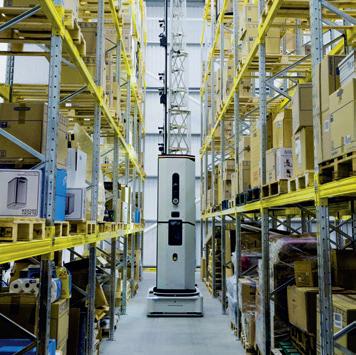

Mastercard is proud to champion women in motorsport, celebrating the heroes of today and inspiring the trailblazers of tomorrow.

James Banfield, co-founder of Performit Live, jokes that the 18-sensor smart system worn by the company’s performers is loosely akin to the hardware in Steven Spielberg’s sci-fi classic Ready Player One, which transports users into the metaverse. And he’s not far o . ose sensors – which capture motion at 1,000Hz, double the capture rate of the biggest animation studios – combined with 16 cameras attached to a performer’s head, record every movement, hand gesture and facial expression in super-high fidelity. at data is streamed to an animator, anywhere in the world, who can then choreograph the whole performance in real time using the Performit Live app.
A digital twin, or in this case a digital character, can then be made to move exactly like the performer. “Most animators are held back by the cost of motion capture production,” says Banfield, who will be demonstrating the technology at FOS Future Lab this year. “Performit Live makes motion capture with professional performers a ordable, leaving you free to realise your vision at a fraction of the cost.”
Currently the company has a roster of 20 performers/actors, all of whom have a particular speciality. One is a former European kung fu champion, many of the dancers appear in the new Wicked film (due to be released in November 2024), and the company’s weapons expert starred in Lord of the Rings – “o en wielding something nasty,” grins Banfield.
“Digital characters have evolved from simple, animated figures to complex, emotionally resonant personas capable of real-time interaction with audiences,” Banfield adds. He sees a future in which these characters perform live on billboards. “ e appeal lies in their ability to transcend traditional marketing limitations, o ering a blend of entertainment, engagement and personal connection that traditional media can’t match.” performitlive.com

A collaboration between Epic Games, makers of the worldwide gaming phenomenon Fortnite, and the European Space Agency means that there’s now an option within the game to explore an accurate digital simulation of the landscapes of the Moon. Taking space video games to a new level of realism, Lunar Horizons is an immersive 3D environment within Fortnite with an educational focus. Players are tasked with undertaking a mission to the Moon’s South Pole, in a game that reveals genuine insight into space travel. e developers worked closely with ESA’s Human and Robotic Exploration experts, even modelling the Moon’s reduced gravity.
“Collaborating with ESA has been an incredible experience,” says James Golding, technical director at Epic Games. “Some of the surprising things we learned during this process included how dark the shadows are on the Moon, where ice resides, and how lunar dust gets everywhere.”
On a logistical level, the unprecedented gaming experience was made possible, Golding adds, by the use of a “virtualised geometry system called Nanite. It enables developers to import photo-realistic models with millions of polygons without a huge demand on computing power. is included ESA’s Argonaut lunar lander and moon rocks that are scanned from real photos.” Playing Pac-Man is just never going to cut it again. epicgames.com
3D milling machine; Dexory’s tech is revolutionising warehouse e ciency. This page (clockwise from top left): a digital hologram of one of Performit Live’s characters; an image from EG’s Lunar Horizons; Royal Navy virtual training with Metaverse VR

Submariners training with the Royal Navy will recently have found themselves working with a virtual reality simulation that brings to life the drills, activities and processes that are all part of the daily routine on board these vessels. “It has a huge impact on the e ciency of training to be able to complete this without needing a submarine,” says Toby Everitt, founder and CEO of Metaverse VR, which creates intensely realistic, immersive training environments that may sound like the stu of Silicon Valley, but are in fact produced by a British organisation with its HQ in Portsmouth. e 40-strong company delivers realistic 3D simulations developed to help train professionals in a range of di erent fields that includes defence, healthcare, the emergency services – and even space exploration. “We have been focusing on our Artificial Intelligence tools,” Everitt says of Metaverse VR’s most recent activities, “which, coupled with our immersive technology, o er some exciting developments in the space and mental health sectors.”
metaverse-vr.co.uk Previous page (from left to right):
e clear advantages of preparing sta for environments where the real-life stakes can o en be life or death suggest that the market for VR training is here to stay.

The shape of beauty.
Ferrari invite you to discover the Ferrari Roma Spider. A timelessly elegant high-performance car, encapsulating a contemporary take on the chic, pleasure-seeking Italian lifestyle of the 1950s and 60s.
Contact your Of cial Ferrari Dealer to discover more.
Fuel economy and CO2 results for the Ferrari Roma Spider in mpg (l/100km) combined: 14.7 (19.2) – 29.7 (9.5). CO2 emissions: 437 – 217 g/km. Figures shown are for comparability purposes; only compare fuel consumption and CO2 gures with other cars tested to the same technical procedures. These gures may not re ect real life driving results, which will depend upon a number of factors including the accessories tted (post-registration), variations in weather, driving styles and vehicle load.

Living well, Goodwood-style: vintage looks, ways to wellbeing, news from the farm, and the history of that summer icon, the strawberry
Grace Kelly in To Catch a ief, Marilyn Monroe’s star turn in e Seven Year Itch, and Elizabeth Taylor’s exquisite Cat on a Hot Tin Roof moment have a common thread: within each Hollywood film, each silver-screen doyenne illustrates the pure power of the white dress. While the LBD is one of fashion’s most famous exports, its ivory counterpart has a quietly commanding presence.
Originally conceived as the innocent uniform of young women being presented at court (all that fresh lace and immaculate embellishment was supposedly a siren call for suitors), it was Queen Victoria who proposed that white dresses should be worn for weddings and their black equivalents for mourning. e romance sewn into the seams of those sweet alabaster designs had Hollywood caught hook, line and sinker, with costume designers such as Edith Head leaning into the drama of colourless looks on screen. e image of the future Princess Grace of Monaco as the naive and impossibly wealthy Frances Stevens in Alfred Hitchcock’s gorgeous 1955 thriller is firmly ingrained in the public psyche, thanks to the look’s unforgettable waspish waist and shocking simplicity. From Princess Diana’s Versace tank dress (an emblem of her freedom in the late 1990s) to Björk’s Marjan Pejoski swan confection, the all-white piece has enjoyed several iterations since then.
For spring/summer 2024, there was plenty to say yes to on the runways in Paris, such as Valentino’s pristine minidresses created using a cut-out embroidery technique linking flowers, birds and, in some rather arresting cases, pineapples. For Gabriela Hearst’s swansong at Chloé, the eco pioneer took classic spring tropes and turned them on their head, with spiralling ivory ru es exploding out from the shoulders. At her own label, Hearst enlisted the help of Bolivian artisans to execute the hours and hours of ornate beadwork bringing her clean looks to life. e frothy, tumbling frills at Dior, picnic-blanket lace at Balenciaga, and light-as-air embroidery at Giambattista Valli also doubled down on the idea of white dresses as blank canvases to showcase age-old cra techniques that outlast the trend cycles.
e Brits, naturally, put a punkish spin on proceedings. Up-and-coming designer Chopova Lowena paid homage to Cornwall’s folkloric Flora Day festival – with its mermaid, maiden and angel dances – via broderie anglaise frocks toughened up with thick belts. Stella McCartney made her undyed dresses almost entirely diaphanous. ere was nothing safe about these modern-day twists on a classic, despite fashion needing to shore itself up in tumultuous times. As Coco Chanel once said, “White has it all. Its beauty is absolute.” is is how to make a statement this spring and, indeed, always.


BY HANNAH BETTS
Fashion folk famously despise the hotter months, considering “summer style” an oxymoron. One takes their point. When the mercury rises, it is a challenge to concoct anything as nuanced as an outfit, in favour of lightness, ease and collective lassitude. Only with the publication of the September issues does languor begin to give way to the return of sartorial rigour. However, there is one form of summer modishness that does possess a certain dash – and one that Britain, in particular, excels in – and that is insouciant sporting chic; a sort of demi-prep, if you will. ink a young Rupert Everett in an untucked shirt and brogues, a cricket sweater tied about his waist, or Anthony Andrews in a tennis vest and boater.
In the fair sex, Fitzgerald’s heroines exquisitely embody this guise: Tender is the Night’s Nicole Diver styling her swimsuit with a rope of pearls down her back, or e Great Gatsby’s Jordan Baker who “wore her evening-dress, all her dresses, like sports clothes…”
is has never more been the case than in summer 2024. I give you Jacob Elordi donning an Abercrombie rugger top in Saltburn; or Zendaya promoting Challengers in a plunging, rhinestone Loewe tennis dress and Jonathan Anderson stilettos, rocking a look that Harper’s Bazaar dubbed “glitzy prep”.
SPORTY STYLE MUST BE WORN IN SUCH A WAY THAT NO ONE COULD EVER IMAGINE YOU ARE ABOUT TO TAKE UP A RACQUET, MOUNT A PONY, OR LEAP INTO A BOAT
Sporty style adopted for non-sporting situations must be worn in such a way that no one could ever imagine you are about to take up a racquet, mount a pony, or leap into a boat. It’s the juxtapositional allure of games shorts with kitten heels, a Pringle tank top with diamanté clusters bedecking each ear, or a sequined slip skirt plus deck shoes, a er Rishi Sunak killed Adidas Sambas. e way to make fitness kit chic is to turn it into an aesthetic rather than a practical choice: a high-low heaven in which smart is undercut by sports.
Key components include the rugby shirt, this season’s equivalent of the too-ubiquitous Breton. Style referents number David Hockney, Chloë Sevigny and Alexa Chung. Minted mavens will crave the £695 Dries Van Noten dresslength take. Rowing Blazers are also rather winning: pick up a 1990s Tommy Hilfiger or Abercrombie & Fitch number, preloved. A Ralph Lauren cricket jumper twinned with a With Nothing Underneath striped poplin shirt or a crisp Me+Em Cotton Crop Tee will conjure the requisite athletic déshabillé.
To finish, it has to be Bass Weejuns, the original Ivy League loafer, with its slot for a penny for the pay phone. Grace Kelly, Audrey Hepburn, Paul Newman and Steve McQueen all kicked about in them. I can’t see why anyone wouldn’t yearn for the black and white incarnation, poised between preppie and princely.

e slingback has but a few simple elements: ankle-strap-enhanced, with a full toe and low or kitten heel… and a uniquely satis ing “hug” feel when you secure them with those tiny buckles (eventually, anyway; expect a heel-blistering time when they’re new). A case can be made for slingbacks dating back to the early 18th century, but in 20th-century fashion, they make appearances on the naughty-but-nice pin-up girls of the 1940s onwards. A style created to make feet look smaller and legs look longer, they were teamed with swimsuits, curves and glossy curls. But the decades that many of us might associate slingbacks with the most are the 1950s and ’60s, when Audrey Hepburn was fond of treading lightly in slingbacks, and Twiggy was sauntering down the King’s Road in them (whenever she wasn’t in their close cousin, Mary Janes). In 1957 Chanel popularised, in fashionable circles, a dual-tone slingback that became one of the house’s iconic styles, with a black toe and so beige upper shoe. Karl Lagerfeld launched a new interpretation of the same in 2015, one of many variants of the slingback that he would design over the course of his career. Everyone knows that heels are about glamour, not about comfort, but having your ankle supportively embraced by a slingback strap comes close to ticking both boxes. Perhaps that’s why these fashion stalwarts go in and out of style, but never quite go away.
Sartorial history lesson – N02
WORDS BY SOPHY GRIMSHAW

In praise of the hairslide

Birmingham-based manufacturer Kirby, Beard & Co first created its “Kirbigrip” hairslide to secure the fashionable new bobs of the 1920s (in the USA, the bobby pin took its name from the haircut). Styles have changed since, but slides were here to stay. In its maximalist form, the flappers’ hairslide became a jewel-encrusted alternative to a tiara. By the 1990s, grunge goddesses wore girls’ plastic slides with heavy irony. Today, the Kirbigrip has gone full luxe: Jennifer Behr bobby pins, as worn by Taylor Swi , are simple slides adorned with jewels.

THE ART OF MENDING A RIP Iron the item of clothing to make the fabric completely flat, then cut away any fraying threads on the two edges. Next, pin some fabric along the length of the rip inside the garment. This will strengthen the mend and stop it tearing further. Thread your needle with colour-matched cotton and knot at one end. Take your needle inside the garment and thread it through to the outside, on one side of the top of the tear. Then thread it back through on the other side of the tear, pulling the edges close with a tiny stitch. Repeat this in small stitches as close together as possible along to the end of the tear, closing it up completely and anchoring it to the strip of cloth. Finally, fasten with a few small stitches and snip off.

THE SUMMER DRESS CODE KNOWN AS “SMART CASUAL” CAN SOMETIMES FEEL LIKE A DREARY UNIFORM. BUT IT DOESN’T HAVE TO BE, SAYS SIMON MILLS
If you have an appointment to meet the King at his Highgrove residence during the spring-to-autumn months – on uno cial business or for an informal meeting – the people from his Buckingham Palace o ce will advise a dress code. For men, they’ll politely suggest “a blazer and chinos”. To this, of course, should be added a shirt and tie (silk, knitted, if possible); brown brogues or loafers; and hosiery (Highgrove is definitely not a sock-free venue).
In other words: the classic and time-honoured “smart casual” attire, that safe and accepted ensemble mu i for summering and cocktails all over the world – from Goodwood to Hollywood, from the Chelsea Flower Show in May to Labor Day weekend in New York.
e only problem is, when you do fall in line with this tacitly prescribed menswear regimen, even if your blazer is well cut and pearlbuttoned, your loafers are to ee leather and Italian, and your chinos neatly tailored and non-Uniqlo, you end up looking like every other man in the pavilion. Or the members’ enclosure. is actually happened to me on one particularly pukka occasion a few years ago, and I have the
slightly comical photos to prove it: our host in ivory-toned Anderson & Sheppard linen, flanked by six code-adherent men who look like they’ve escaped from a 1990s J Crew catalogue shoot.
e good news is, other summer outfits are available. Some o er subtle variations on the classic American blazer/cotton pants theme. Others, meanwhile, veer more towards the Continent and the Caribbean, or even back to flamboyant 1970s Paris.
Executed correctly, your summer style should respect the breezy informality of the invitation but also hint at it being a special occasion. Dress up, not down: no trainers or flip-flops; no shorts; no T-shirts; and do wear a jacket, even if it’s sweltering. Don’t feel you have to stick to the pastel palette of pale blues and dusty pinks; dark colours such as navy and olive green look super-chic in the sunshine. Accessorise with a flute of fizz and investment sunglasses: those tortoiseshell Aristotle Onassis numbers by Tom Ford or Cubitts, maybe? To finish, add a pocket square and (assuming you’re not at Highgrove) tanned ankles. Here are 10 more ways to avoid the tyranny of the blazer and chinos.
Nothing says summer like the crisp rustle of seersucker. is light, thin, puckered cotton fabric is ideal for warm weather, its name deriving from the Persian words “sheer” and “shakar” (“milk” and “sugar”) in acknowledgement of the material’s contrasting smooth and rough surfaces. Seersucker’s wrinkles are designed to improve air circulation and have a cooling e ect on the wearer. Classic colourways include blue and white, pink and white, yellow and white, light brown and white, and all navy. Ralph Lauren is your man for summer seersucker.
A safari jacket was the blazer alternative for Yves Saint Laurent in his swaggering 1970s Rive Gauche prime (and also for modern-day Arctic Monkeys front man Alex Turner). You can find excellent variations at Cordings, Beams Plus and New & Lingwood. Cinch it at the waist with a belt and add a silk scarf or neckerchief, but don’t be tempted to go full Out of Africa/Boy’s Own adventurer look. Add loafers instead of desert boots, and leave the bullwhip in the car – this is the Festival of Speed not e Temple of Doom
Remember back in 2014 when President Barack Obama donned a beige-coloured suit (rather than one of his usual skinny-cut navy-blue wool jobs) for an important press conference? Obama’s critics railed at his lack of judgement and over-casual sartorial choice, the incident becoming known as “the tan suit scandal”. Well, it’s time to embrace Obama’s “audacity of taupe”. Pick up your own scandalous tan suit at Hackett or Brooks Brothers. e new style is looser, with wider, high-waisted pants. Wear it with this summer’s essential: a blue denim cowboy shirt, at least two pearl snap-buttons open.
If the event is more casual than smart, the posh summer cardy, as worn by the Roy family at many a mountain summit meeting, superyacht get-together or Tuscany pow-wow in TV’s Succession, is always an option. Styled like a deconstructed shawl-collared blazer and usually of a silk/cotton or merino wool mix, the luxiest ones come from Brunello Cucinelli. Wear yours with a linen summer scarf.
WHITE JACKET
Walk into the party like you are walking onto a yacht – and do it in a dazzling white blazer. Go for Polo Ralph Lauren’s 100 per cent cotton canvas version, ironed but not totally wrinkle-free. A dark shirt will both formalise it and tone it down.
CUBAN SHIRT
at old Cuban classic the Guayabera (pronounced “gwah-yah-be-rah”) is a traditional short-sleeved shirt in a white, pale blue, lemon or pastel hue. e classic cut is loose, boxy and hip-length, adorned with four, sometimes two, patch pockets and vertical rows of decoratively embroidered sewn-in pleats. Original Cuban and vintage versions are nice but o en made of a synthetic mix fabric. Better to go for a touch of Euro/Havana deluxe with Connolly’s all-cotton or linen “Baruc” shirt, a collarless variation with gorgeous detail and superlight construction. Accessorise with a Montecristo No 5 cigar.
WHITE JEANS
Instead of chinos, try white jeans or white linen trousers. White goes with anything – a vintage Madras jacket, a navy blue blazer, the aforementioned Succession cardigan – but to avoid looking like a Noughties Elizabeth Hurley, buy your white pants straight cut, clean but worn in, maybe with 1950s tennis player pleats, and definitely not TOWIE tight.
A very old style but a comparatively new utilitarian fashion category, French “chore” (ie task or job) apparel includes worker jackets and trousers in heavy-duty cotton. is was originally available in a distinctive, cornflower-blue tone and worn by farmers, cra sman, mechanics and railway workers. e simple and practical patch-pocketed style has now been adopted by mature Shoreditch hipsters and re-imagined for the premium market by menswear labels including Folk and Margaret Howell. A look with versatile, socially mobile appeal, it’s a suit, yes. But not, you know, a “suit” suit.
Going to Goodwood Revival? e “gentleman racer” will always win podium status when it comes to style. e coverall or “boiler suit” became a utilitarian fashion item in the 1940s when Sir Winston Churchill commissioned Jermyn Street tailor Turnbull & Asser to make him a selection of bespoke “siren suits” in pinstripe serge and green velvet. Go to e Goodwood Shop for your own GRRC overalls in khaki or light blue. Wear them with a shirt and tie, or cravat, and swan your way into the VIP area, Stirling Moss-style.






Think of the biker jacket and there’s a good chance you’ll conjure up something American – an image of Marlon “ e Wild One” Brando in his Schott Perfecto, perhaps. Biker cognoscenti, on the other hand, will be pondering the likes of Steve McQueen, Iggy Pop, John Lennon, e Sex Pistols and Motörhead, or maybe the so-called “Ton-Up Boys” of the UK’s own burgeoning biker culture of the 1950s and ’60s, all wearing their Lewis Leathers.
“Our Britishness certainly helps Lewis Leathers’ appeal, but we cover a lot of bases: motorcycling history, punk, street style and, of course, those who just want a timeless, functional jacket,” says Derek Harris, Lewis Leathers’ owner. “Lewis always seems to be something of a new discovery to a lot of people.”
ose people have, as it were, been a bit slow o the lights. Lewis was established as a London tailor and outfitter by one Lewis Isaacs in 1896. Using the business name D Lewis, Isaacs later began to specialise in creating clothing for gentlemen who engaged in the then extremely novel pursuits of motoring and flying. Indeed, it was the company’s experience making flying jackets, suits and boots for the RAF during World War II that perfected its eye for utility, recognising, for example, that the riding
WE COVER A LOT OF BASES: MOTORCYCLING HISTORY, PUNK... AND THOSE WHO JUST WANT A TIMELESS JACKET
style on British café racer motorbikes – hunched forward in low profile – demanded action pleats at the back and covered buttons at the front, so as not to scratch your petrol tank.
ose are the kind of details you find on the Bronx model, largely unchanged since the 1950s “when it was created for a new, younger generation of motorcycle-riders who wanted to dress di erently from their fathers,” Harris explains. Or there’s the Lightning jacket of the 1960s, with its quirky equestrian cinching buckles – punk rock’s go-to and still Lewis Leathers’ best-seller. Such features are saluted in the second volume of Wings, Wheels and Rock ’n’ Roll, a celebration of Lewis Leathers’ vintage style – published in November.
Unsurprisingly, like so many British greats, Lewis Leathers is most fervently appreciated abroad, notably in Japan, where there’s even a slang term –“Lonjan” – for one of its “London jackets”. at might explain why Lewis Leathers also has long-standing collaborations with the likes of Comme des Garçons, Hysteric Glamour and e Real McCoy’s, and why it recently opened stores in Tokyo and Osaka.
“ ey just can’t get enough of our jackets out there,” enthuses Harris, which also explains the 6–10 month waiting list if you want to get one here.

It’s an unlikely kind of fashion accessory, the dog tag. Its origins are intertwined with the advent of industrialised warfare – with the Prussian military first giving out identification tags in time for the FrancoPrussian War in 1870 – having learnt their lesson from the Battle of Königgrätz four years previously, when out of almost 9,000 Prussian casualties, barely a twentieth could be readily identified. Printed onto metal, the new IDs bore the wearer’s name, army number and unit –and became known as Hundermarken because they resembled the tags worn by dogs to prove their owners had paid Berlin’s dog-licensing fee.
In the 1900s both the British and American armies followed suit, with the latter introducing the concept of issuing double tags to each soldier during World War I – one tag to remain with the body, the other taken away for record-keeping. So the dog tag comes with an unmistakeable suggestion of mortality, even as it nestles with its metal chain upon a living, manly (or womanly) chest. at no-nonsense military vibe is what gives the dog tag a hint of edge, inspiring designer imitations from the likes of Ti any and Emporio Armani. But it looks altogether more convincing when unmediated by fashion, as worn by Jake Gyllenhaal in Jarhead or a very young Tom Hardy in Band of Brothers. We salute them both.
Moustaches come in all shapes and sizes, from the handlebar, named a er that part of a bike or motorbike, and the Clarke Gable (like it says on the tin) to the “chevron”, which is currently having a moment in the ever-changing landscape (hairscape?) of men’s facial hair. is particular ’tache takes its name from the inverted V-shaped insignia used to denote military rank – think of the stripes on a sergeant’s arm – or very possibly from the logo of Chevron, the American oil and petrol company. But whatever the etymology, the aim is to create the graphic statement of a flattened V –as exemplified by Tom Selleck as the legendary Magnum, PI back in the 1980s. e chevron moustache should ideally be quite thick and substantial, but it also needs to be carefully groomed to prevent it from becoming too bushy – which would make it a Dallas (aka “the lazy man’s Chevron”) – or, heaven forfend, forming a messy fringe over the upper lip, which would make it a Walrus. And we certainly wouldn’t want that, would we?
US Army dog tags like these were first introduced during World War I

JOHANNA
If the sound of the gentle thwock of tennis ball on racquet gets you salivating for something sweet, you are not alone. An icon of British summer, the strawberry is a fixture of the warmer months, its UK season starting towards the end of May, depending on the weather, and running all the way through until September.
Brits have been eating strawberries since at least the 1500s. e Tudors and Stuarts nibbled on tiny wild Alpine varieties of strawberry, and omas Wolsey, Lord Chancellor to Henry VIII, is reputed to have been the first to serve the strawberry with cream. It didn’t save him from being accused of treason later, but if the legend is true, it was the start of the simplest but most delicious of English summer desserts.
e fat, sweet strawberries we know today are the result of careful crossbreeding by horticulturalists. e sweetness initially came from the American “Virginia” strawberry (a relative of the “Little Scarlet” now used widely in jam-making), which was brought to England in the 16th century. is was crossed with a larger Chilean variety during the 18th century to make the kind of strawberry we’re familiar with now.
e Royal Horticultural Society has tested strawberries and advised gardeners on the best ones to grow since 1822. In the 19th century, these chubby red berries became so synonymous with the British summer, they were known abroad as Fraises Anglaises. e oldest variety still grown is “Royal Sovereign”, originally bred in 1892, but more modern recommendations include “Honeoye” for early crops, midseason “Malling Centenary”, and, for late crops, “Pegasus”.
Rob Copley, director of Farmer Copleys Farm Shop, near Pontefract, grows several varieties to service another great British tradition – that of going out to pick your own strawberries. “ ere are two main types,” he says. “ e 60-day strawberries, which give fruit for three weeks, 60
days a er you plant them, and everbearers, which never have lots of strawberries on them, but start producing at the beginning of June and run right through to September. When side-by-side, every variety tastes completely di erent.”
And there are more varieties than you might think. “In Europe, there are about 60 di erent strawberry cultivars grown commercially, and about 48 that are available as plants to UK gardeners, as they are more suited to our mild Atlantic climate,” explains Guy Barter, chief horticulturist for the RHS. “But in the United States Department of Agriculture germplasm collection in Oregon, there are over 500 di erent strawberry cultivars.”
While the UK isn’t the world’s largest grower of strawberries – that’s actually China – many will associate strawberries and cream with the Wimbledon fortnight, where the dish was first served at the inaugural event in 1877. Now the tournament sells more than 38.4 tons of strawberries annually. But our appetite for these beloved berries can’t be limited to a mere two weeks in June and July. ey are a feature of gatherings throughout the summer. Every year at the Qatar Goodwood Festival, for example, racegoers are served around 58,000 strawberries. In 2020, when the races were cancelled at short notice due to the pandemic, these were swi ly turned into jam that was shared around local food bank charities.
And perhaps this is part of the joy of strawberries for Brits. During the warmer months they can be slathered in cream, mixed in with meringue for Eton Mess, baked into a tart, frozen into ice cream, dropped into a jug of Pimms, or consumed straight from the punnet at a picnic. But when preserved in jars as jam they can make the summer feel like it’s stretching out that little bit further.
Join us for strawberries at Qatar Goodwood Festival, 30 July–3 August 2024

“If you’re in any doubt as to whether or not the food is ultra-processed, it probably is,” says author, broadcaster and doctor, Chris van Tulleken. He’s speaking into his laptop on a video call from the London home that he shares with his wife Dinah (who is a fashion editor, stylist and art director) and their two young daughters. e family cat also pops up periodically to share the screen with him.
“If you’re looking at an ingredients list and seeing anything that you don’t find in a domestic kitchen – things like xanthan gum – then you’re looking at ultra-processed food,” he says. “ e same if you’re eating any kind of pre-prepared food, like a ready-made lasagne. e conversation has changed a bit, though, because companies are cleaning up labelling, so it can be harder to tell just from ingredients.”
An associate professor at University College London Hospital, van Tulleken is best known as a health broadcaster for BBC TV and podcasts, almost always seen alongside his twin brother and fellow doctor, Xand. e brothers are joint hosts of everything from a CBeebies show to a Radio 4 series about exercise. But trying to change the national conversation around ultra-processed food (UPF) has been very much Chris’s solo project, culminating in his bestselling 2023 book Ultra-Processed People. He begins the book by distinguishing processed food – which can simply mean putting food in a can, or heating it – from UPF, which is where the health harms come in.
“Ultimately, if you’re eating something that’s made by a giant company with shareholders, you’re usually eating ultra-processed food. And the purpose of that food,” van Tulleken explains, matter-offactly, “is to take as much money from you as possible, and to use the cheapest possible ingredients to go in the food that the market will sustain, making the foods as addictive as possible. Anyone in a food lab will tell you these things openly. It’s really no secret.”
He is unimpressed by the voluntary “tra c light” system of labelling by which he points out a product like a so drink with sweeteners can at face value appear positively healthy, with few red lights. “ e tra c lights are voluntary; if they are on something, it’s because it’s helping to sell the product. What we actually need to do is use very tight definitions of levels of salt, fat, sugar and sweeteners, and we can label almost all ultra-processed food.” He points to the example of Colombia, where a more accurate system using di erent black octagons achieves this – “one for salt, one for sugar, one for sweeteners and one for saturated fat” – and shows me a box of Colombian Froot Loops by way of example.
Ultra-Processed People is, by turns, readably entertaining and genuinely shocking in the way it reframes your view of common foods, with some fascinating tangents (including how, in Nazi Germany, some “butter” was literally made from coal). roughout, van
DR CHRIS VAN TULLEKEN’S
BESTSELLING BOOK LIFTS THE LID ON THE HARMS OF ULTRA-PROCESSED FOOD. IT’S TIME FOR A TOTAL RETHINK, HE TELLS SOPHY GRIMSHAW

Tulleken emphasises that UPFs are addictive and “designed to be overconsumed”, which is why they are so problematic when it comes to the topic of weight gain. “UPF is optimised to make you eat as much of it as you possibly can, as o en as you possibly can,” as he puts it. It’s not only obesity that’s a resultant problem, though, but a long, gloomy rollcall including cancers and dementia – the higher “all-cause mortality” risks to which UPF is linked. And yet UPF is everywhere. “On average, about 60 per cent of our calories come from UPF,” he says. “But it’s very normal for it to be 80 per cent, especially with young people. So this is our national diet and our food culture.”
His book may ruin, for the reader (as it did for him… and for me), many popular snacks, so drinks, breakfast cereals, ready meals and ice cream. In fact, it was a casual observation that his daughter’s ice cream steadfastly showed no signs of melting on a hot summer’s day that prompted van Tulleken’s investigation into what goes into our food. He has now adopted a low- or no-UPF diet, as has his twin brother, but he is scrupulously careful to deal in hard facts rather than preaching. He is working instead towards promoting a shi in public understanding about the nature and e ects of UPF.
“I definitely don’t propose a ban or taxes on UPF. My project is for the reader to get something useful – a tool, if you’re struggling with this food, to want it a bit less. But that is ultimately between you and your
fridge. What I’m really trying to do is build a population that will vote for change. For politicians to act, they need a mandate from people who are angry about this.” A er we speak, he is preparing to speak to the House of Lords about these issues. “I don’t envy the position the government is in, but that won’t stop me telling the truth.”
He is aware, too, that some of the most disadvantaged people will find it hard to opt out of UPF consumption, saying that “policy should make good food a ordable and not make life harder for people living in poverty. At the age of 10, some 25 per cent of children leaving primary school are living with obesity. We should be taking drastic action. We have allowed a situation to develop over the past four decades where we have massive inequality. ere are houses where people only have a microwave to cook with and for a huge number of people there is no choice, for reasons of geography and economics, but to eat UPF.”
But he also points out that the ubiquity of UPF means it spreads beyond any one social group or body. “Health-conscious families may have low-sugar ketchup, low-fat yoghurt, low-salt breakfast cereals, but it’s all still UPF. We need a system change of the whole food environment, so everything looks di erent when you walk into a shop.”
e second annual Goodwood Health Summit takes place in September. Ultra-Processed People by Chris van Tulleken is out now
“Ultra-processed food has become our national diet and our food culture”




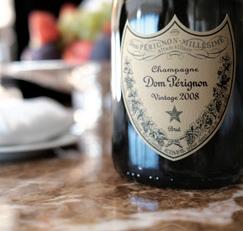
Embark on a holiday that creates memories to last a lifetime.
Whether you’re commemorating a milestone anniversary or birthday, or gathering for another precious occasion, let us enhance every moment through the warmth and personalised service of our wonderful crew and the splendour of The World’s Most Luxurious Fleet™
Set sail with Regent Seven Seas Cruises® for a voyage filled with unforgettable moments.
TO LEARN MORE SCAN THE QR CODE CALL 023 8082 1373 VISIT RSSC.COM/UNFORGETTABLE-MOMENTS OR CONTACT YOUR TRAVEL ADVISOR




PART OF OUR LANDSCAPE AND ECOLOGY SINCE THE BRONZE AGE, BRITAIN’S HEDGEROWS ARE FIGHTING BACK AFTER YEARS OF DECLINE, FINDS ROBIN MAYNARD
In 2000, author Bill Bryson related how an outraged supporter of the Campaign to Protect Rural England had characterised the destruction of our hedgerows: “No one would think of tearing down a quarter of England’s mediaeval churches. But that’s precisely what we have done with our hedgerows.” Bryson, who went on to become president of the CPRE, continued, “For well over a thousand years, they have been a defining attribute of rural England, the stitching that holds the fabric of the countryside together.”
It’s easy to see why hedgerows evoke such lyricism when the spring flowers of blackthorn and hawthorn illuminate their bare branches, but don’t bring either indoors; country lore has it they bring ill-luck, even death – aspersions cast on them for once being sacred to pagan deities. Hedgerows exist not for their beauty or religious significance, but their utility. Oliver Rackham, a leading authority on the British countryside, cites archaeological evidence of our ancestors adapting vegetation to protect crops and livestock in the Bronze Age. Anglo-Saxon charters record already “old” hedges, as well as those newly planted. Many came about from the clearance of woodland, their edges becoming boundaries for the new fields; “ghost woods” providing a thread back to ancient “wildwood”.
e “Great Enclosures” of 1750 to 1850 were a golden period for hedgerows, with more planted over 100 years than in the previous 500, as agriculture rushed to
keep pace with the Industrial Revolution’s growing workforce. Soil fertility relied on the rotation of crops and livestock. Hedgerows were essential infrastructure – holding animals in the pasture on one side, away from the crops on the other.
Across the UK there are more than 30 regional variations in the style of their management, known as hedgelaying (or “plashing” in some dialects). Shrub and tree species are allowed to grow for 10–15 years, then partially cut at their base and “laid” at an angle, held in place by hazel stakes to form a living barrier. Key species include blackthorn, hawthorn, bramble, briar and dog rose.
Hedgerows’ rootedness in our landscape had seemed guaranteed: comparing 17th-century parish maps with those of the early 20th century shows little change. en came war. During World War II, more than 2.5 million hectares of grassland went under the plough to boost domestic food production, and hundreds of miles of hedgerows went with it. Even greater losses followed over the next 50 years, driven by government policy and subsidy, accelerating when the UK joined the EU and its Common Agricultural Policy. Food surpluses, rather than shortages, caused public concern, and almost half of the UK’s remaining hedgerows were ripped out as fields were enlarged and amalgamated. is unstitching of the fabric of the countryside only slowed with the passing of the Hedgerows Regulation Act of 1997 making it illegal to remove certain hedgerows. In the topsy-turvy world of agricultural policy, farmers started to receive grants for replanting the hedgerows they’d been paid to remove.
Last year, the Government set a target to restore 45,000 miles of hedgerows in England by 2050. A welcome signal. But quality, not quantity, is key: 60 per cent of our hedgerows are in poor condition. eir optimal management would be by traditional hedgelaying, but that can’t compete on time and cost with a singleoperator, tractor-mounted “flail” – hence 97 per cent of our hedges are “flailed” currently, which o en results in smashed stems and a gappy, open structure.
Greater than the UK’s entire road network, they act as a natural super-highway
If hedgerows functioned merely as a barrier, barbed wire would have triumphed long ago. But with the UK being one of Europe’s least wooded countries, these “ghost woods” provide a vital habitat for up to 80 per cent of our native woodland birds. Human infrastructure usually hinders nature; hedgerows help. Greater than the UK’s entire road network, they act as a natural super-highway criss-crossing the country. As a photosynthesising infrastructure they provide additional carbon capture and storage, and are estimated to hold 9 million tonnes of carbon.
At Goodwood there are big hedgerow-planting ambitions. As Sophia Llewelyn, who is coordinating the project alongside forestry manager Darren Norris, explains, “Connectivity between blocks of woodland with hedgerows allows for many species, including mammals, insects, birds and even bats, to travel in relative safety between sites for food or breeding purposes. ere is also growing evidence that the root systems from hedgerow trees will draw water up from lower levels and create microclimates, ensuring better growth of other nearby plants.”
e Estate is looking at establishing “super hedges”, which are between 5 and 10 metres wide. Norris adds: “ ese would be allowed to grow naturally rather than trimmed to a set square shape. Natural hedgerows have a dark entangled core that’s perfect for nesting songbirds, dormice and other small mammals. In winter they are home to insects, spiders and roosting birds. e outer edges of the hedge, by not being trimmed every year, bear much more blossom and fruit – a better food source for wildlife, plus lots of berries for making jams and gin!” Semi-natural structures and ecosystems created by us, hedgerows flourish with our active intervention. at’s why I’ve signed up for a hedgelaying course next winter, so I can turn words into action. My inspiration is the 300-foot “Phoenix Hedge”, which runs alongside a school playground in the Bristol suburb of Henleaze, and is estimated to be 800 years old. Standing beside it, I sense it
its country cousins.

During the summer, our cows and sheep are out grazing; we rotate them around Goodwood Home Farm so they aren’t on one piece of grass for too long. We check on them twice a day and make sure they have plenty of water. Around July, it’s also time to get the sheep’s fleeces off so they’re nice and cool. If we don’t shear them and they get too hot, there’s a chance they could get something called “flystrike”, which is where flies lay eggs in their fleeces that then hatch into maggots. Flystrike is really unpleasant for sheep, so it’s a welfare measure to shear them.
At this time of year we make silage, cutting the grass to preserve it for the winter months, when it will be the mainstay of our cattle feed. In order to do that we set aside certain fields with a grass and clover

mix, because grass is high in energy and clover is high in protein. We cut the grass and let it wilt in the sunshine for 24 to 48 hours, then collect it with a forage harvester to be heaped, compressed and stored. This process ferments and preserves the grass when it’s at its best quality.
In many ways summer is a busy time, and yet the atmosphere at Goodwood Home Farm has a pleasantly lazy feel to it. Red Admiral butterflies flit past, the light is different, and you get the sense that everything on the farm has been growing and reaching its full potential. It’s at this stage that you feel you could take a picture and everything would be just how it’s supposed to be. Learn more about farming at Goodwood, and the organic produce available, at goodwood.com

































JULY 4
WHISPERING ANGEL DINNER
Our Whispering Angel dinner returns to e Putting Green at e Kennels for a delectable four-course dinner, paired with the finest selection of Provence rosés from Château d’Esclans.
JULY 25, AUGUST 29
SUMMER SUPPER CLUB –SMOKE & FIRE
Indulge in a unique alfresco dining experience on e Putting Green at e Kennels, with your supper cooked on an open fire. Enjoy a delightful array of dishes showcasing fresh seasonal ingredients and produce from the Goodwood Estate.
JULY 27
GOLF AT GOODWOOD INVITATIONAL
e perfect opportunity to bring a guest and show them all that Goodwood has to o er golfers.
JULY 30, AUGUST 3
QATAR GOODWOOD FESTIVAL DINING
Whether it’s for a summer barbecue lunch on e Putting Green, or lunch and dinner in the restaurant, e Kennels is the perfect place to start and end your day during the Qatar Goodwood Festival. A complimentary shuttle is available to take you to and from the Racecourse.
JULY 30, AUGUST 3
QATAR GOODWOOD FESTIVAL AFTER RACING MUSIC
When the action on the Racecourse has finished, the good times continue at e Putting Green. Our complimentary shuttle buses will ferry you to e Kennels where you can continue your evening with fantastic food plus music from our DJ.
AUGUST 4
CLASSIC SUNDAY BREAKFAST CLUB
Our traditional midsummer celebration of cars and motorcycles that were registered before 1 January 1984. We welcome vehicles from the dawn of motoring right through to humble heroes like the Renault 5 Turbo.
AUGUST 10, 18
CLUB CHAMPIONSHIPS
e pinnacle of the Golf At Goodwood calendar, the Club Championship is a 36-hole medal competition played over both e Park and e Downs courses.
AUGUST 11
GOODWOOD GUT HEALTH PROGRAMME
Our five-day holistic retreat is a transformative gut health overhaul, expertly designed for a restorative e ect on body and mind. e programme combines nutritional advice, results-driven therapies and specialist support to help you establish new, healthier habits for life.
AUGUST 17–18
WIM HOF RETREAT
Explore the pillars of the Wim Hof Method including breathing technique and cold exposure. Discover how committing to mastering these components could help unlock a host of health benefits.
AUGUST 23–25
SUMMER RACING AND FAMILY FUN
An enchanting three days of racing commences with the annual Friday night fireworks spectacle, lighting up the skies over West Sussex. On Saturday and Sunday, enjoy a relaxing weekend combining live music and summer entertainment, providing a wonderful social occasion for family and friends.
AUGUST 31
VINTAGE MARKET AT THE KENNELS
Step back in time on e Putting Green and find fabulous vintage or vintageinspired clothing, shoes and accessories from the 1940s, ’50s and ’60s – with everything you need to complete your Goodwood Revival look.



Every year, the Festival of Speed brings together an astonishing array of cars and motorcycles for the world’s greatest celebration of motorsport, car culture and technology. In 2024, MG will take centre stage – in its centenary year – with a soaring Central Feature display. e theme, “Horseless to Hybrid – Revolutions in Power”, will celebrate the advances in technology that have shaped motorsport from its origins to the present day and looking into the future.
e 2024 Festival of Speed presented by Mastercard gives visitors unrivalled access to cars, bikes, drivers, riders and teams. Oracle Red Bull Racing will be staging the largest in-person celebration of its 20-year anniversary, bringing a multitude of championshipwinning cars and arguably the starriest line-up of drivers the Festival of Speed has ever seen. Legendary Richard “ e King” Petty will make a final visit to Europe, as the Petty dynasty celebrates 75 years at the heart of American motorsport; teenage sensation Oliver Bearman will make his Goodwood debut with the Ferrari F1 team; “Mad” Mike Whiddett will be back with his latest creation, a McLaren P1 GTR dri car; and Ferrari will show the customer version of its Le Mans-winning hypercar, the 499P Modificata.
Elsewhere, visitors can explore “Technology for a Better World” in Future Lab presented by Randox, with a focus on robots, pilotless cargo planes and drones; the Goodwood Action Sports Arena will showcase amazing feats on two wheels; and the Cartier “Style et Luxe” concours d’elegance will feature a jaw-dropping line-up of cars and celebrity judges. Only ursday general admission tickets remain, with Friday, Saturday and Sunday now sold out, although a limited number of hospitality packages for all days are still available. Tickets and packages can be purchased at goodwood.com from £70


Home of the flagship Qatar Goodwood Festival, Goodwood Racecourse’s worldfamous five-day meeting will draw the attention of the entire horseracing world from Tuesday 30 July to Saturday 3 August. e week is headed by three Group 1 races –the Qatar Goodwood Cup, the Qatar Sussex Stakes and the Qatar Nassau Stakes – with equine superstars competing for close to £5 million in prize money. e all-women’s charity race, the Markel Magnolia Cup, takes place on ursday 1 August. is year, Aamilah Aswat will become the first student from the Riding A Dream Academy to compete in the race. e programme, part-funded by Goodwood Racecourse, was set up to further Khadijah Mellah’s ground-breaking success in 2019, which captured the attention of the world.
As much as “Glorious Goodwood” represents the pinnacle of global horseracing, it is also a unique social occasion. Visitors can sip Veuve Clicquot at the Champagne Bar, or enjoy a summer spritz with a range of delicious gin cocktails curated by Hendricks. ere is live music on the Earl’s Lawn and fabulous fashion, including the return of the bestdressed competition on Friday, alongside hospitality to savour – and all in the spectacular setting of the world’s most beautiful racecourse. Whether you’re a horseracing aficionado or a complete novice, the Qatar Goodwood Festival is one of the must-attend events of the English social season.
Every picture tells a Goodwood story

Since graduating from Central Saint Martins and launching her eponymous label in 2014, fashion designer Molly Goddard has dressed everyone from pop star Rihanna to artist Cindy Sherman in gowns that revel in being bold, bright and flamboyantly voluminous. A 2018 episode of Killing Eve, in which Jodie Comer’s Villanelle wore a frothy pink tulle Molly Goddard confection, took the designer to new heights. In 2022, Goddard drew inspiration from Goodwood, creating gowns as the winner of the Goodwood Talent in Fashion Award in association with the British Fashion Council. The Duke of Richmond said her look “fits perfectly with Goodwood’s approach to fashion, which embraces a glamorous yet relaxed style. We have always been known for this quintessentially ‘England in the Summer’ way of dressing, ever since the future King Edward VII and Lillie Langtry visited during the 19th century.”
Past recipients of the Goodwood Talent in Fashion Award include rising star Sohee Park, of Miss Sohee, while the winner of this year’s award is Turkish-born, London-trained designer Bora Aksu.



